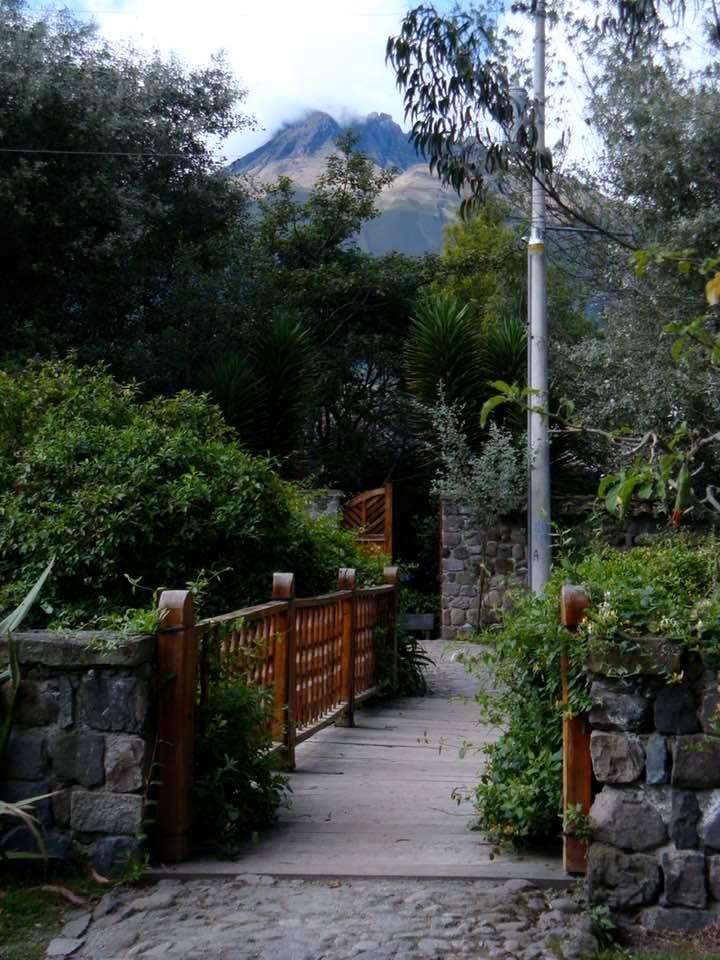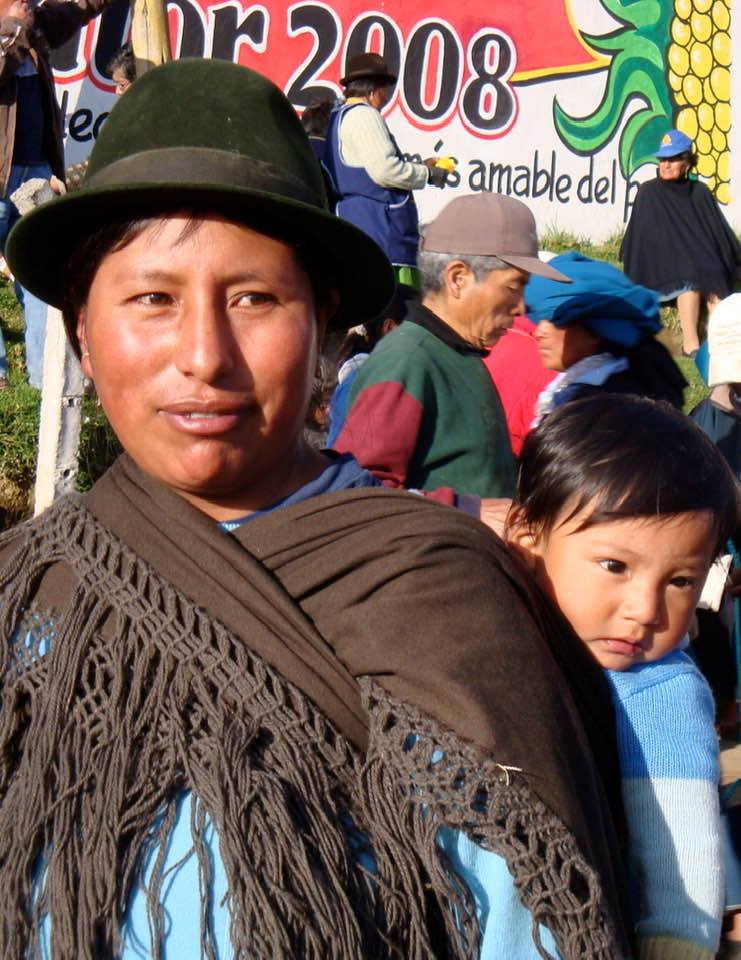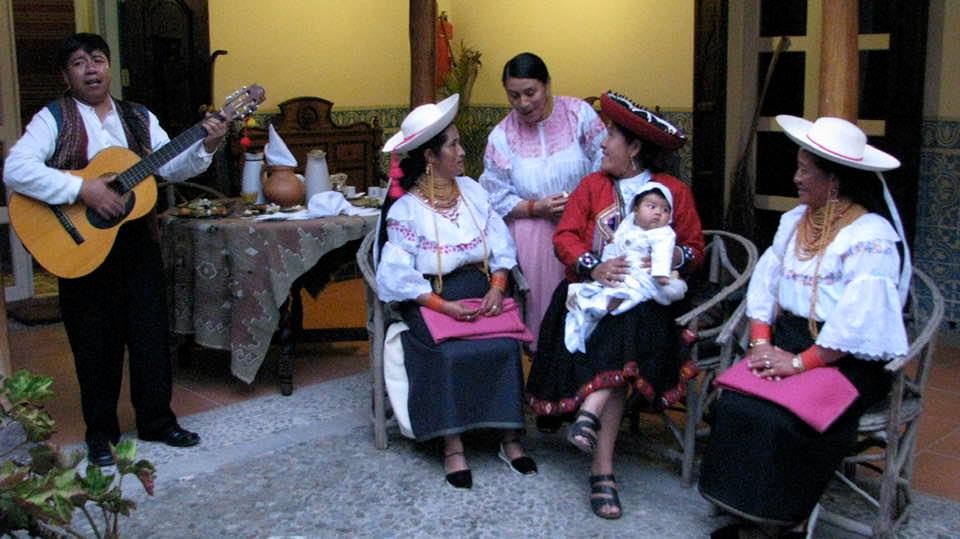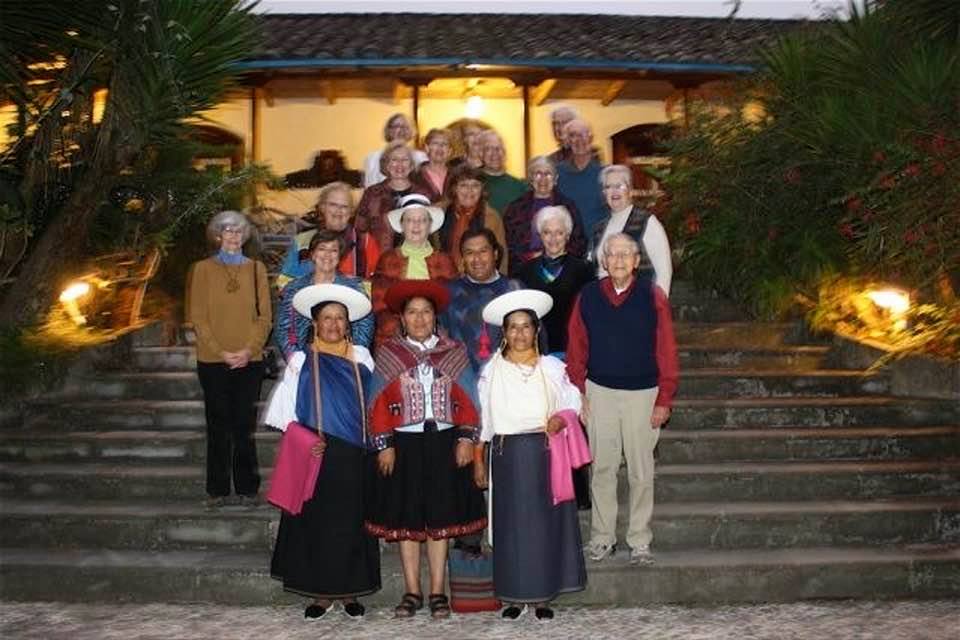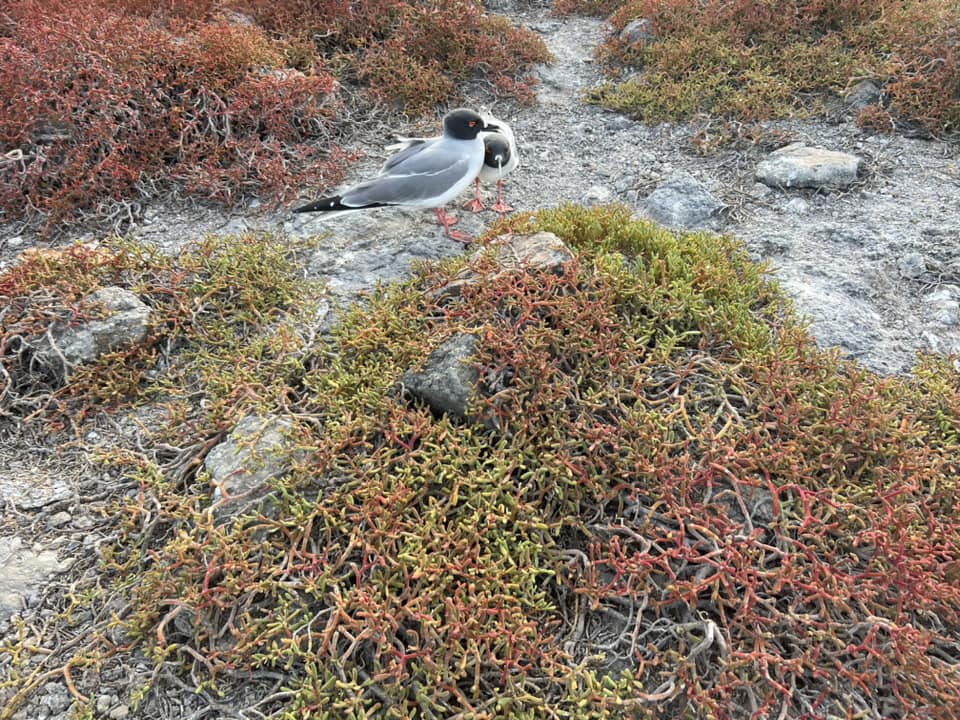
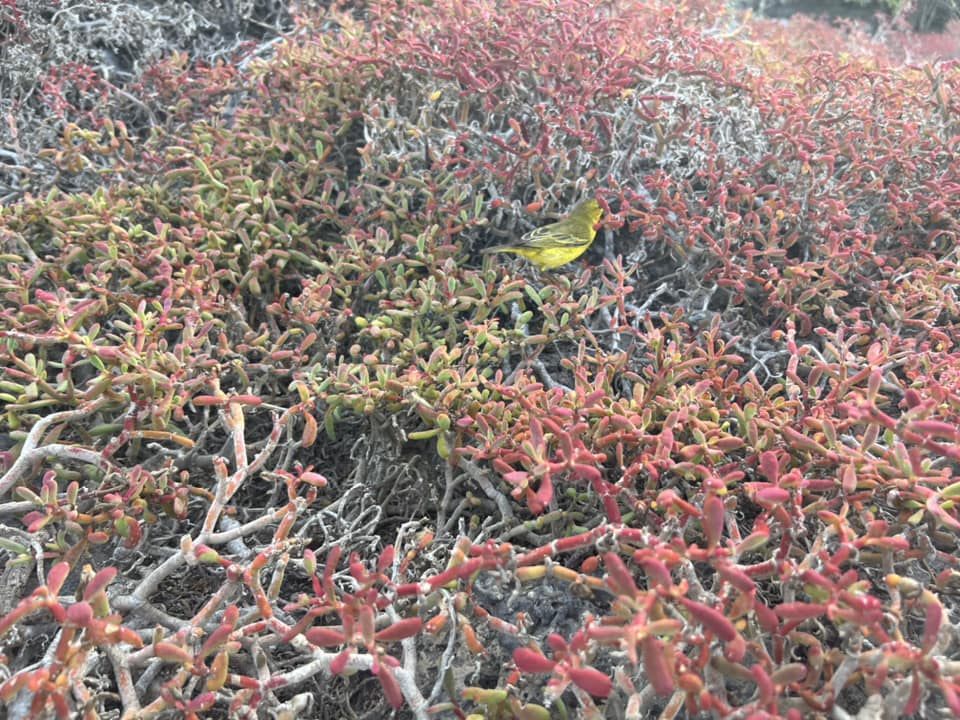
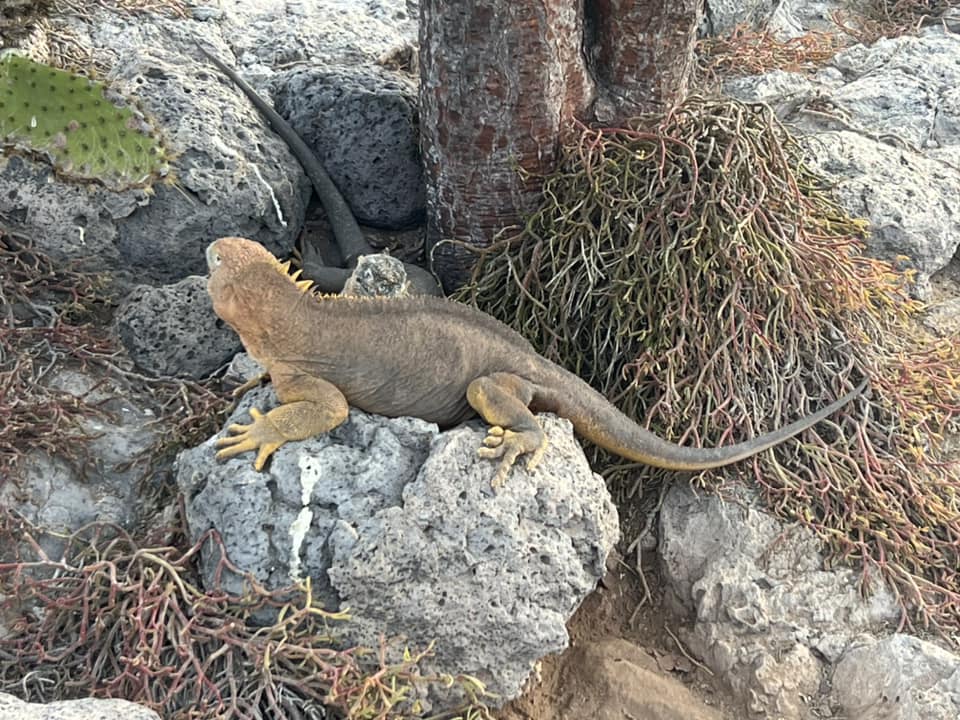
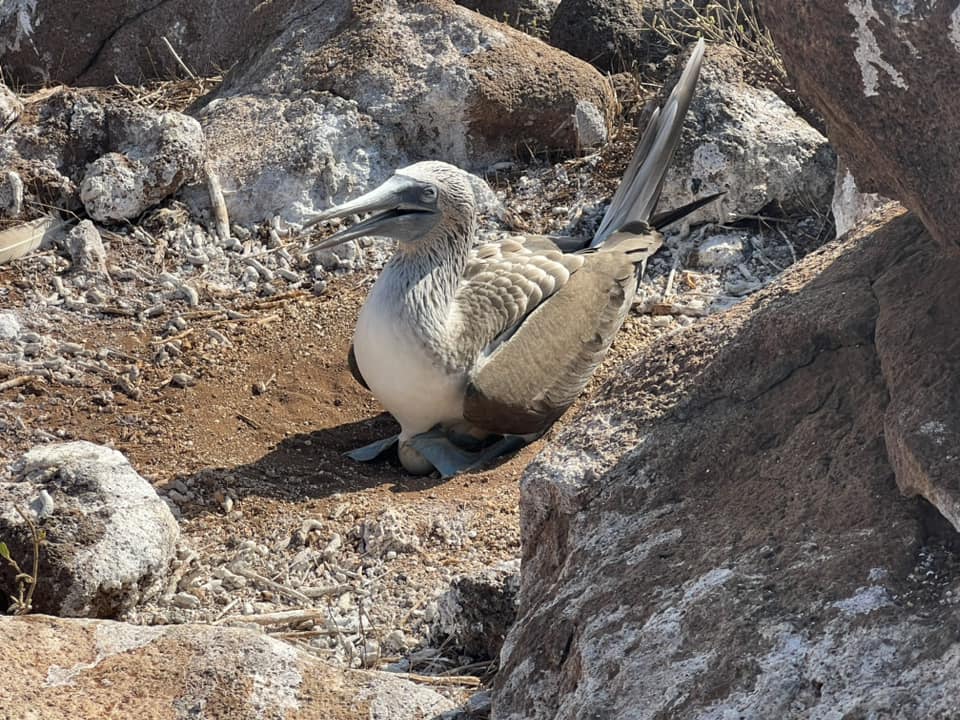
Blue footed boobies nest on the ground. The red footed ones nest in shrubs about a foot off the ground.
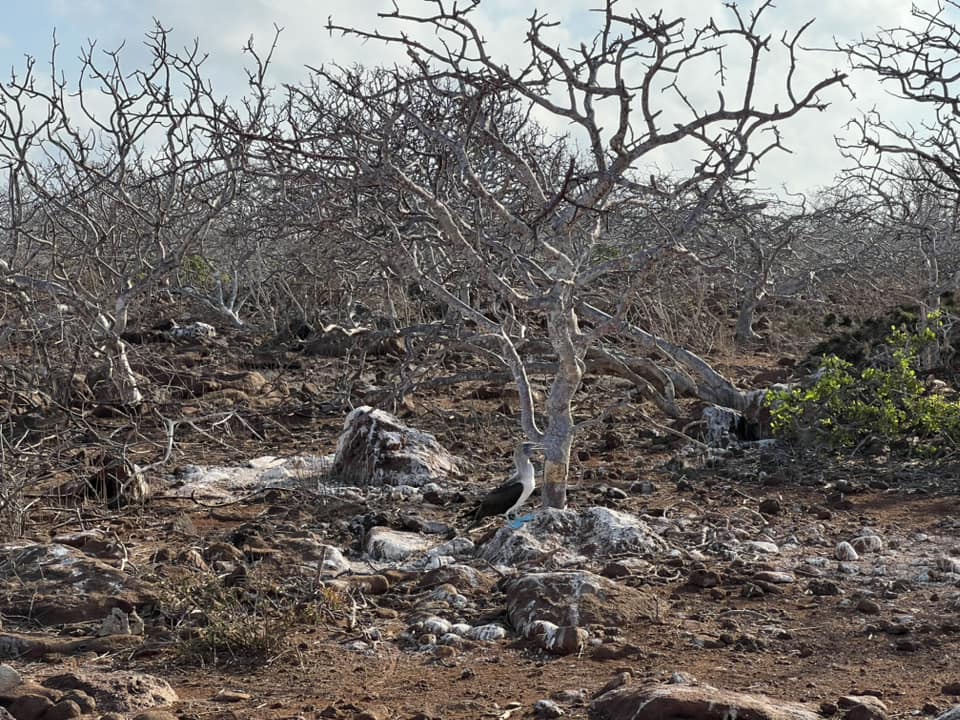
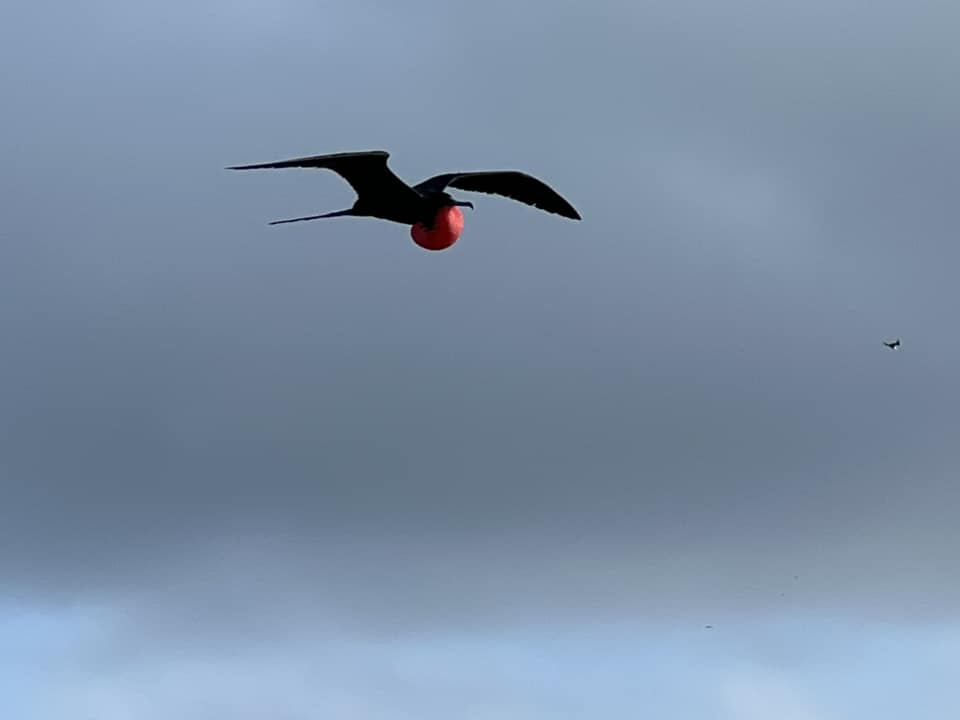
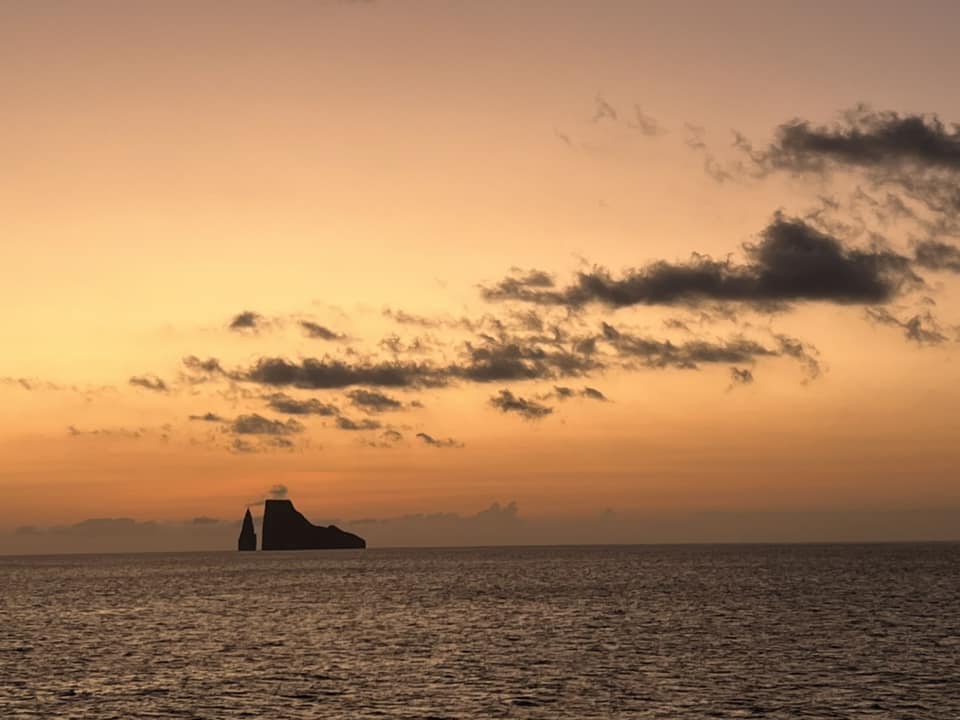




Blue footed boobies nest on the ground. The red footed ones nest in shrubs about a foot off the ground.




Hello Travelers & Friends,
What is more fun than heading out on a trip?
….to know that a pod of friends and like-minded travelers will be heading out to enjoy the views with you. We have some fun on our calendar this February as we head out with 3 pods of small groups to the Galapagos Islands, the High Sierras of Ecuador, and then on southward to Patagonia and Tierra del Fuego. It has been a true delight to plan these journeys after two years of pandemic hibernation. Thus, we remind you:
A Few of Our Favorite Views &
When You Might Want To Go Too!
SPAIN
Spring is beautiful in the Northern part of this country in April & May, or choose the Fall season after the summer heat abates. Try out September or October, but we have learned to respect Columbus Day when the country shuts down for serious celebration in the streets! This trip can be adapted to your preferred level of activity: from day hikes to van touring. See a few stories here:
https://newviewtours.com/all/gardens-art-of-spain
South West FRANCE
The Castles and Caves tour is in a beautiful and popular part of the country. Consider April/May or September/ October on the shoulder seasons around when the caves close for the winter. This trip involves walking on cobblestones, through well-worn dark passages, and with some uneven lighting. The castles all have steps and cobblestones and spectacular views! There are new interpretations of the “meaning” of the cave paintings. Fertility marks? Hmm. Come look for yourself with an experienced guide.
https://newviewtours.com/traveljournals/france/france
ECUADOR
On the equator, this country is open and beautiful 12 months of the year. The predictable rainy season in January and February is uneven, so we go anyway and find delightful days; welcoming hacienda experiences, walks, and hikes in unique ecosystems with the company of well-trained English-speaking guides – so special. Hacienda Cusin has hosted New View Tours small groups of friends and families for over twenty years! We are grateful to them for this. We predict you too will feel at home while you find a new view at the same time!
This trip adapts for all activity levels to enjoy!
https://newviewtours.com/calendar/peaceful-gardens-trails-a-trip-to-ecuador
GALAPAGOS ISLANDS
A morning flight from Quito via Guayaquil transports you to the once-remote volcanic islands. Some are, yes, populated including hotels and restaurants. Others are completely uninhabited. To create the lowest impact on the abundant endemic species, please consider a cruise. The boats are carefully scheduled to avoid crowds. We will suggest our favorites; the boats are booked well in advance. Let us know what time of year works best. The cruise will have you disembark at various unique spots as if to be the first to discover each and every variety of wildlife; bird, reptile, or animal still existing, thriving, relatively undisturbed. We have experienced “boots on the ground to assist. Be in touch so that we can arrange a 3, 4 or 8 day excursion at your activity level. https://newviewtours.com/traveljournals/equador/galapagos-travels
PATAGONIA, CHILE
The seasons are the reverse of our own, so a November to February excursion is at the peak of summer and a beautiful time of year. Our trip this year starts in the Fall season. We expect to see the changing colors of the papallacta trees, among other treats. Will the blue calafete berries still be on the bushes? We add on a new view of Tierra del Fuego, thanks to the preparation of our host, Tamara, who lives there. The Torres National Park will be a “must”, now one of 17 spectacular national parks in the southern Andes, thanks to the foresight of the Tomkins Conservation Foundation and the country of Chile. This is a marvelous trip for the intrepid travelers among us. It is important to be able to walk distances comfortably and be able to make long van trips.
https://newviewtours.com/calendar/patagonia
New Views for Fall 2023:
The Picos de Europa mountain range offers stunning hikes on the ancient trails of shepherds and pilgrims. Let’s connect to a train excursion from Bilbao to Barcelona!
Castles and Caves of Southern France;
let’s add on days in Bordeaux & Toulouse.
New Views for Winter 2024:
There is a new view of the North Atacama Desert in Chile; let’s start in Santiago, and enjoy Valparaiso on the coast before finding the Atacama Desert – a brand-new view!
Ecuador explore – so many choices: fly Quito to Cuenca; drive between Cotopaxi and Cotacachi volcanoes! Rest and restore at Hacienda Cusin, retreat in the Cloud Forest….
Summer Travel Note: During this naturally busy season, the above trips may work best for you and yours. Because it is busy and often very hot, we recommend a detailed itinerary with visit times pre-reserved, train tickets pre-purchased, and guides pre-arranged. In short, please let us help you pre-plan carefully.
Thanks So Much To You!
Your support and endorsements from those of you who have traveled with us! Your notes made such a difference! Here are a few of them:
https://newviewtours.com/testimonials
Have a memory of a trip with New View? A favorite picture?
Send it along!
We have been at this for twelve years; subtracting two years lost to the pandemic – it is ten!
Health and Harmony throughout 2023!
Ramelle & Michael
Ramelle1@mac.com
Michael2@me.com

Lascaux IV – a new museum offers a complete reproduction 500 meters from the original cave. Lots to learn as theories keep bubbling up and its new technology that makes it possible!

Spanish Plaza built for the Worlds Fair in Seville

The Seville Cathedral at night.
New View Tours Designs Trips with Your Interests in Mind:
Art, Gardens, Writing, Walking, Birding, History
Bring a group, Bring a class, or
Just Friends!
See comments here:
Enjoy the chilly days of winter!
Happy Trails,
Ramelle & Michael Pulitzer
Email either of us with comments or questions.
We are delighted to chat!
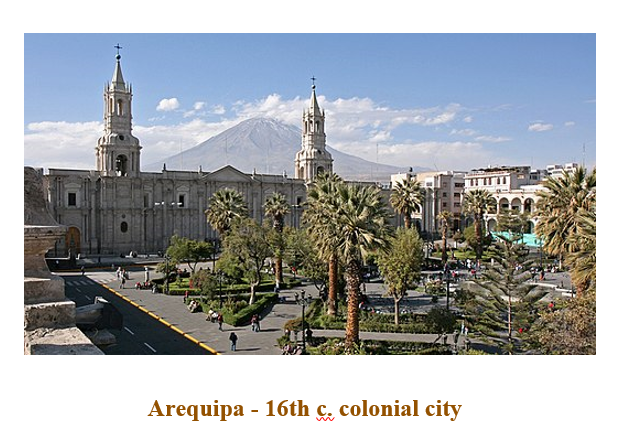
PERU
From 16th century colonial cathedrals
to Inca ruins to home of the condor in the largest canyon in SA
Arequipa, to the Colca Canyon to Puno & Lake Titicaca.
Estimated Land Cost based on 2018 trip $ 2650
Add—on tour to Machu Picchu.
More Info contact: Email Ramelle or Email Michael
Michael Pulitzer teaches a Gentle Yoga series that includes meditation. The practice draws on the ancient eastern styles of Hatha, Meditation Pranayama, Vinyasa and Yin, and the contemporary teachings of Kripalu, and Restorative postures. These techniques work in a sequence to access each student’s potential for a fully realized experience.
Michael’s classes are for all levels including beginners and those desiring to re-engage their practice.
Join me to have fun, build awareness, energy, and feel good for a meditation on the breath and on sensation. Classes are available on Zoom by emailing me at Michael2@me.com for the link.
Michael is a 500-hour certified yoga and meditation instructor through Kripalu Center for Yoga. He also holds a certificate in Positive Psychology and Dynamic Gentle Yoga. He began his inquiry and yoga practice in 2000 while working in television broadcasting.

A trip to the Azores offers a perfect balance of island lifestyle and European culture amidst beautiful mountains, deep lakes formed by volcanoes, tropical forests, and a variety of ports, beaches, scenic coastlines. Sao Miguel Island is the largest of 9 in the archipelago 900 miles off the coast of Portugal. Punto Delgada, the capital, is a city paved in black volcanic stones and white marble tiles imported from the mainland. Here, the largest port accommodates cruise ships that stop over regularly, their passengers pouring into the city’s restaurants, shops. the military museum situated in the 1522 fort, a formidable stone fortress, the Forte de Sao Bras.
We visited in February 2020 and again in September 2024. Camellias bloomed in coiffed gardens, light rain passed through followed by beautiful skies. Island life agreed with us.
Flights are direct from Boston, New York in only 4 hours. Other airlines have routes connecting through Lisbon. Be in touch and we can help you figure this out.
Let’s Go! Hold a spot for the first week of May 2025. Be sure to contact us as we will tailor the tour just for you and your friends and family interests!

Take a 4×4 Jeep to explore the views from the rim of the volcanoes!
Distinctive black stone-faced buildings line every street, each paved in different patterns. Can’t remember which way to go? which street to turn down? Where to find the name? Look down to the tile!
The talent for cultivating gardens is ubiquitous. Pineapples are grown here. The only tea plantation in Europe is thriving here. We attended the camellia festival, too early for the azaleas of March and April. Highways lined with leafless stick hedges carefully manicured awaiting May and June blooms of hydrangeas.
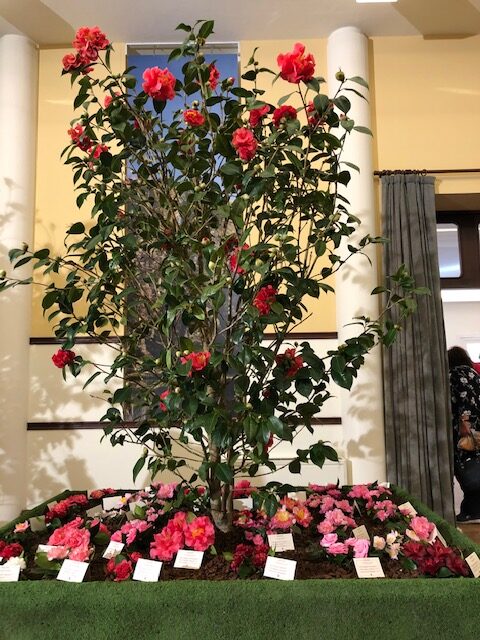
C Amelia Festival – abundance across from our hotel with lots of crafts for sale too!
For a day in the city, we found a one-hour bus tour that circumnavigated the city. Next, we stopped at a small but over-stocked museum created by Carlos Machado that houses his collection of sea mammals, plant life, unique land animals, and a wide assortment of diverse flora and fauna from these remote islands – the naturalist of his time. If we had one more ounce of energy, we might have seen the military museum situated in the 1522 fort, a formidable stone fortress on the waterfront, the Forte de Sao Bras.

Near Ribiera Grande, the north coast, a stunning modern hotel with private swim pools.
Volcanoes recently formed these islands, geologically speaking. The mountains feature slim rims, deep walls to bowl-shaped lakes. It is a fascinating landscape of lush vegetation around deep blue waters. Therapeutic hot waters spring up from the core of the earth, the heart of a volcano; stained by iron to a brown color is considered healing. Everyone swims in the muddy looking pure stuff. At the deco style Terra Nostra Hotel, find a very large pool gushing with steaming water all year long, perfect on a rainy afternoon.

Chefs are amazing – this is Asian fusion fare!
Each city on the island is new discovery. Riviera Grande, only 20 minutes from the capital, the 2nd largest city, is known for its historic center and northern beaches where windsurfing is a favorite. The town is at the gateway to the crater lake, Lagoa do Fogo, one of 5 on this island.
Hiking is a joy. Maps along the way clearly mark the distances and details of changing elevation. Many trails are wide enough to be accessible by 4-wheel drive jeeps. Local guides cheerfully escort!

Another church
Restaurants are excellent, but growing in popularity. It is important to find reservations or arrive early. The local version of mussels is on every menu. The local stew is “cozido” steamed for several hours in the hot volcanic soil. This takes so long, it is ordered a day in advance. The chef will use a large metal pot with a strong handle. Layers of pork or fish and sausage steam in beds of root vegetables, beet greens, potatoes, and cabbage. The whole pot is submerged in the naturally streaming ashes of the volcano floor to cook through the day.

Typical black volcanic stone carved in Portuguese style with plaster walls
Known as the Hawaii of Europe, the Azores are 900 miles from the colonial capital of Lisbon, on the same latitude with Bermuda and the same time zone as Iceland – four hours change from the east coast. A lush paradise of islands, mountains, and pastures, the best times to visit are March through October. Winter months can be windy and rainy, but still beautiful. Summer months are crowded as the European visitors flock to these islands as a relief from the heat.
We suggest a 7-night tour: 2 in Punta Delgada; 2 in Ribiera Grande and 3 nights or more in Furnas at the luxurious deco hotel, Terra Nostra Garden Hotel or equivalent. Then add on a short flight to see other islands: Faial, Terciera or the relatively remote islands of Flores and Corvo (that I plan to explore next myself).
With direct flights from Boston, New York, and in-season, Providence RI, the Azores Islands make a unique and welcoming destination.

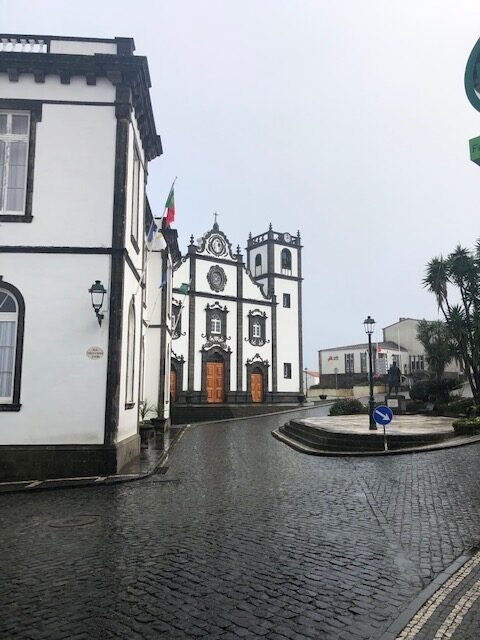

Typical view of the ocean – looking east in the late afternoon – these skies change all day

A nice little rainbow forming – a raincoat is a good idea – but rarely needed for long

Mountains to the sea! There are many happy sea creatures in these deep waters

The enormous bowl of a volcano is settled with a town, Furnas in its center

The thermal pools burst through the ground to share steam and gasses and hot waters

This is where pots are buried to cook “cozido” layers of food. Each circle claimed by a different restaurant
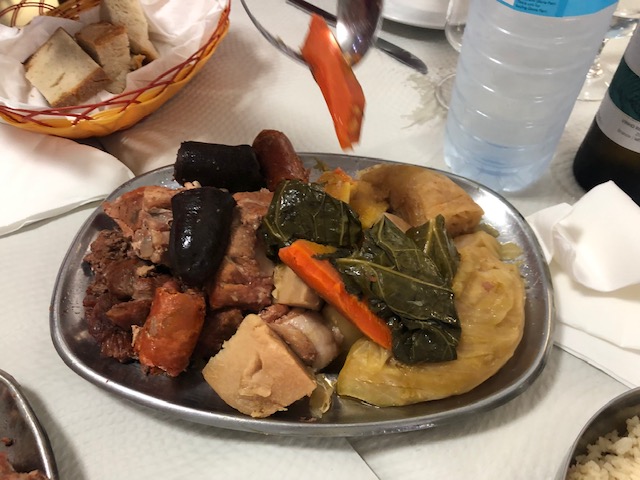
Ahh 8 hours later
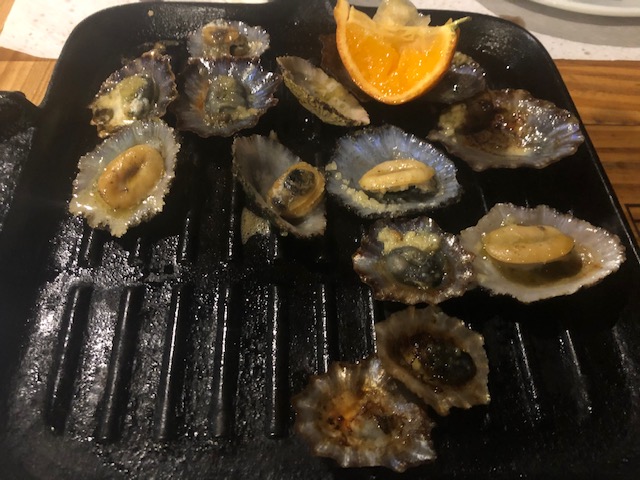
These are mussels here cooked with lots of garlic

Farming the same way still. Milk and beef from the islands is extraordinary. Wheat is brought in by boat for local bread makers. Pineapples sent back on the same boats.
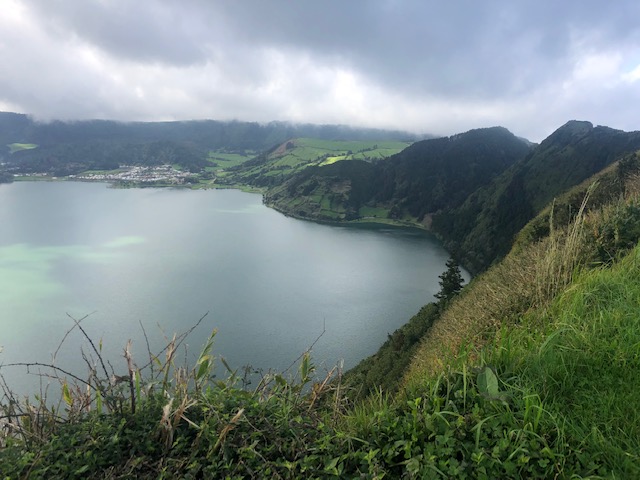
Steep walls of the mountains look straight down to the Sulphur waters.

Cultivated Stream


Azaleas blooming early in one of the many gardens throughout the islands
Detailed itinerary available at the end of September. Watch for posts on Ramelle’s Substack platform, Facebook, and Right Here!
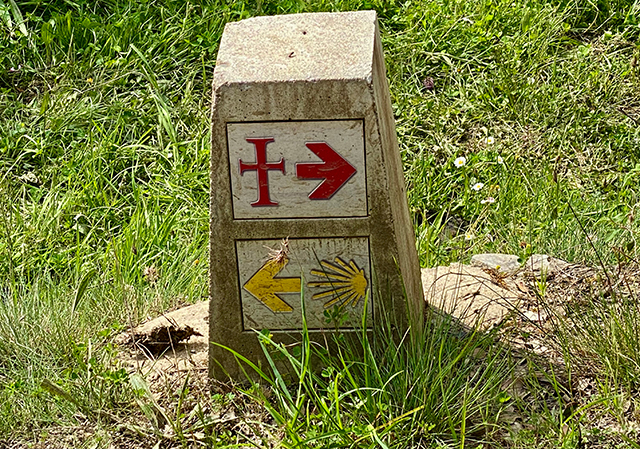
A section of the route to Santiago de Compastella – through Lebanon province
We continue on from inn to inn: Casa Tollo to Casa Oso is 14.5 kilometer. Don’t even bother to convert to miles. It is a very long day. We get confused finding the first part of the trail; at midday, I find I am climbing an extra mountain, and by late afternoon it is a crazy traverse through a wide unmarked field where Michael and I find the muddy sections. As we descend through the apparently uninhabited village of Cosgaya, it is one more kilometer down to turn left into the front entrance of Casa Oso, “Bear House”, our third hotel, This means that the next morning after breakfast, thankfully served early at 8 am, we will be turning right to a first ascent!
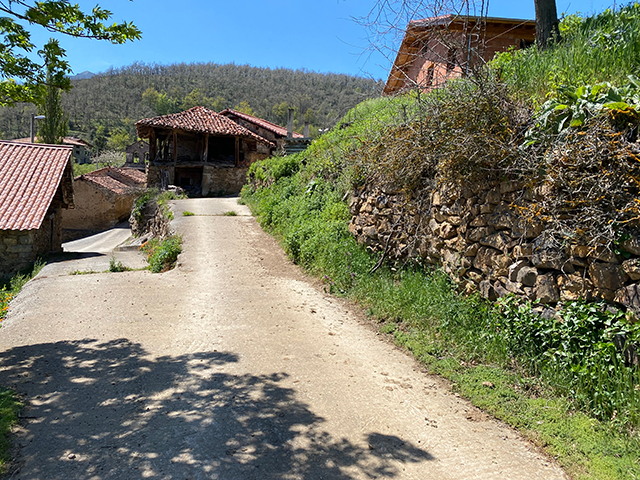
After this hamlet, I’ll take a wrong turn for a few kilometers up the wrong mountain, but I see from the app how to drop down to be ahead of the others!
We were a muddied, tired, and windblown couple after a beautiful trek. (Sandy & Ellie made much better time than we did today.) Our disarray is a stark contrast to the manicured entry, the nicest one so far. In sock feet we shuffle our way to the second floor, dropping very dirty clothes in a heap in a corner before a hot shower. Yes, it is a relief that restores us; a lovely dinner, nice white wine, a soft bed with a warm cover and the soothing rush from the river pour in through an open window. I am feeling particularly grateful for first class on the trail. Our boots are returned cleaned up thanks to the attentive, but furiously busy attendant who calmly found a plastic bag to store them. (Make up your own picture of this!)
This morning’s breakfast is an enormous buffet of choices and the coffee from the worst coffee maker ever designed, ubiquitous in Europe, the Nespresso. At least thIs one actually makes some dark liquid stuff!
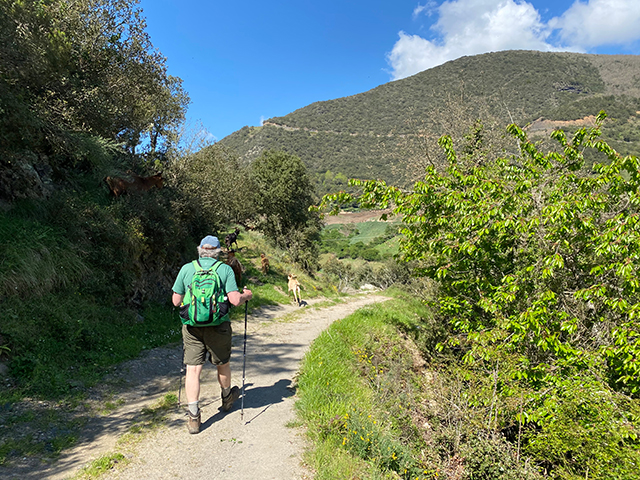
Off we go, daypacks laden with tap water, (safe and tasty right from the tap) picnic sandwiches of ham and cheese between large white roll. These we transfer immediately from the unnecessary gold paper bags they have just dropped the sandwiches into. This bulk doesn’t stuff well in day packs that need to carrying extra layers for sun, rain, cold and what ever blows at us. A piece of fruit is a miracle. A piece of chocolate would have been, too. It’s fine, it’s fine.

My blisters are not a topic for mealtime conversation, but while I have you here on the page, let me suggest to any hikers a new type of flexible bandaid called Nexit. Also, pack in the suitcase an extra pair of old favorite boots. I had my Ahnu’s that became a game changer. (The company was sold to TEVA but no longer the same!). No more rubbing thanks to these same old reliables that had taken me over the Torres del Paine in Patagonia, through the Rockies, around and about the Berkshires, and now these Picos de Europa. Boots and bandaids!
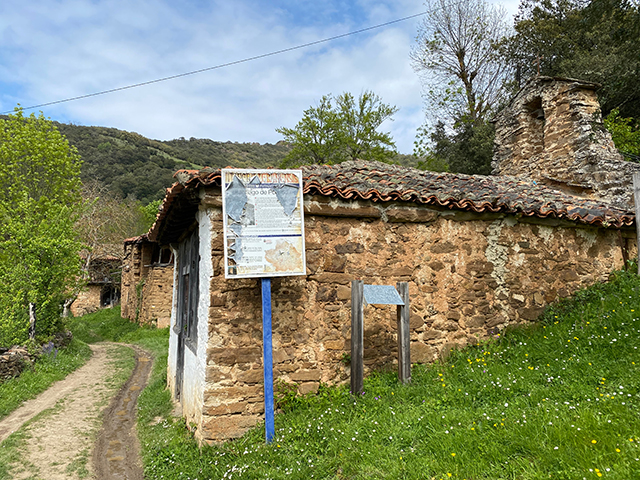
The paths are usually dirt roads. Narrow trails begin higher in the mountains with thin signs to mark which way is which. Hmmm. Most of the time they are helpful. Many times the historic ones are extremely weathered.
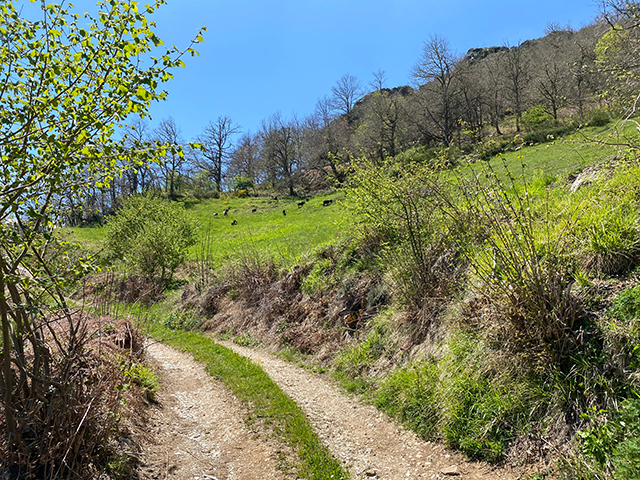
See the black flecks on the field? Goats.
Cows and sheep of all colors, goats and strong healthy horses dot the landscape. Some are near farms, visibly fenced. Others seem to be left to roam, though it is early in the season. Most stock are brought up after June 1st when their young are raised and ready.
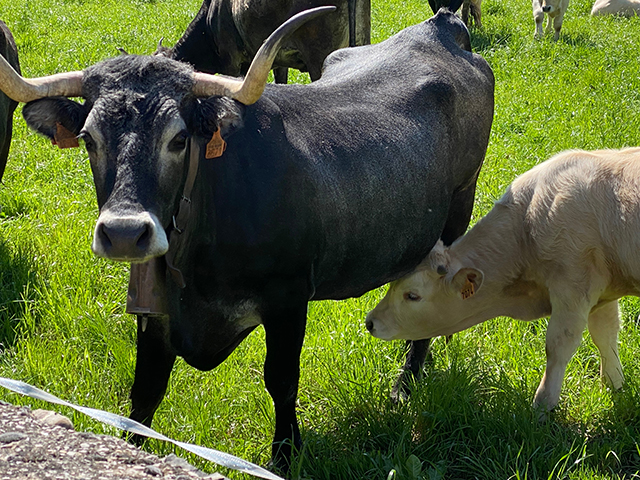
Still iin the field in town; maybe a dozen calves with their mothers here.

New life!
Hiking – one step at a time is the cliche after 12 or 15 thousand of them. A numbing takes place. The energy is directed to the legs, the lungs. The pump system, the heart, pulses fuel through the streams and canyons of the muscles circulating oxygen where it is needed; a miraculous process. My brain just carried on relaxed, up here for the ride.
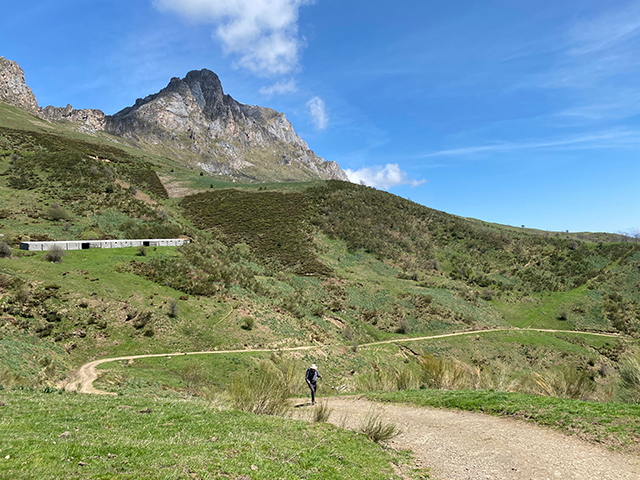
Michael in his own time and place
When legs get truly sore, the best strategy is to rest ‘em, add a sip of water, a bite of chocolate, pause for the views, take a close up pix of new plantings, pause for the expansive vista, look back to reflect. Then it’s onward like a new day is just beginning.
Thankfully, most trail of this trail is relatively stable underfoot. Hours of views of green pastures, gravel roads, abandoned villages, one with the”for sale” sign has me amused. Fun, I think to myself, I’ve found my next fixer-upper. Heck with a castle I saw in France; let’s go for a whole village in northern Spain!
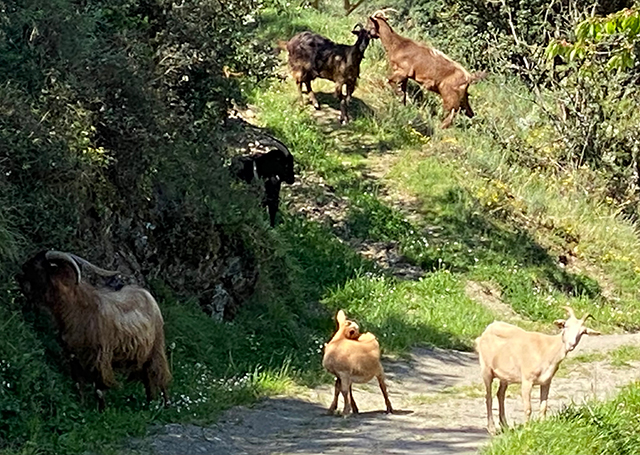
Large goat on the left (looked like a yak to me!) is the billy goat, luckily very shy!
At one point, my reverie is interrupted by a large van full of birdwatchers that appear on the far side of another abandoned hamlet at a paved road access. I had not seen or noticed paved roads before. The “watchers” are trying to see birds behind the new leaves that we have watched spring forth on all the trees. 3 days ago, as we began our trek, the view was open. Amazing to be able to watch the spring leaves grow right in front of our eyes.
One of the bird watchers comes up to me to ask, “Where are the people here?” “ Well you are the first I have seen”, I reply. Their tour guide is quickly herding this one back to his flock to focus on the leaves, I mean birds. It’s true that we saw no other people on the trail for most of the 8 days. Exception: at the parador in Fuente De, where large groups of travelers had rebooked past tours at the large hotel. We found motorcyclists, a group from Great Britain, and the 4 of us!
Tomorrow, we will be in Fuente De, the fountain or spring of the De River…..one step at a time!
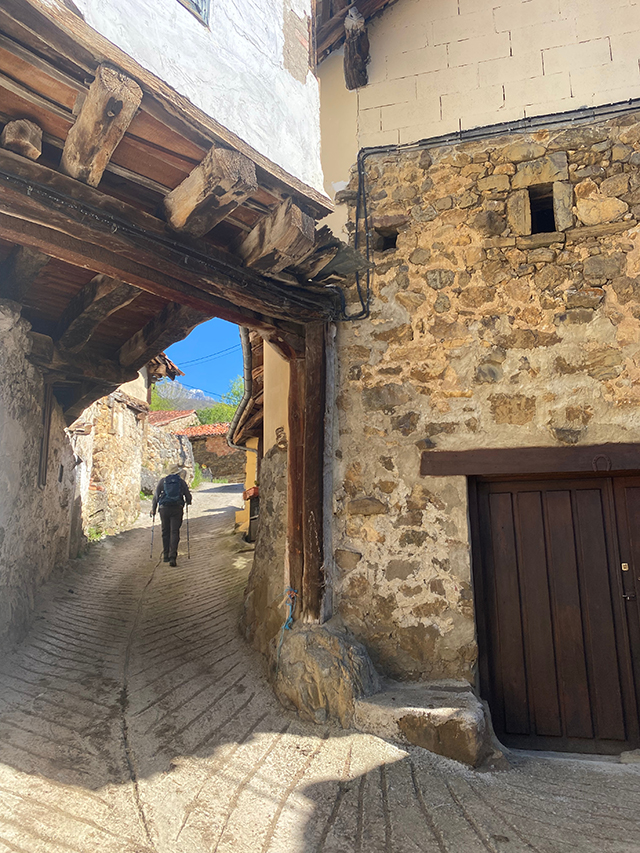
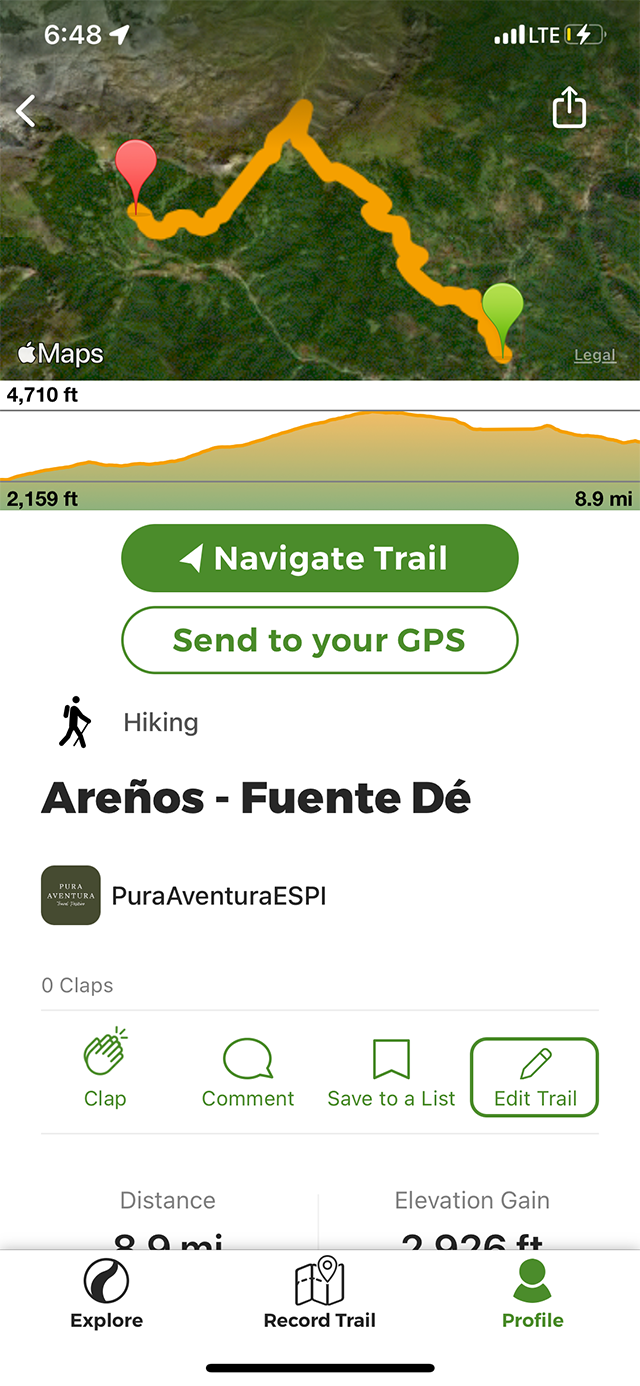

Side street in Potes. Flowers blooming in pots of all shapes are everywhere…
By lunch time on Day One, the town of Potes looks great! We descend from the worn dirt trail to the first asphalt road to the square with church, castle, bridge over a river: yes the most beautiful Pueblo in Spain just like the sign says.
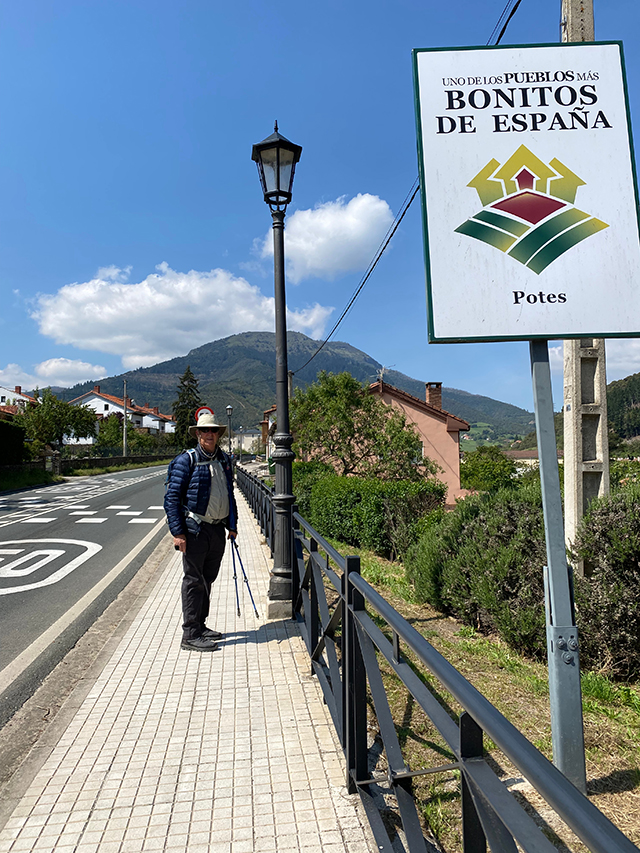
It is remarkable how few people we see!.
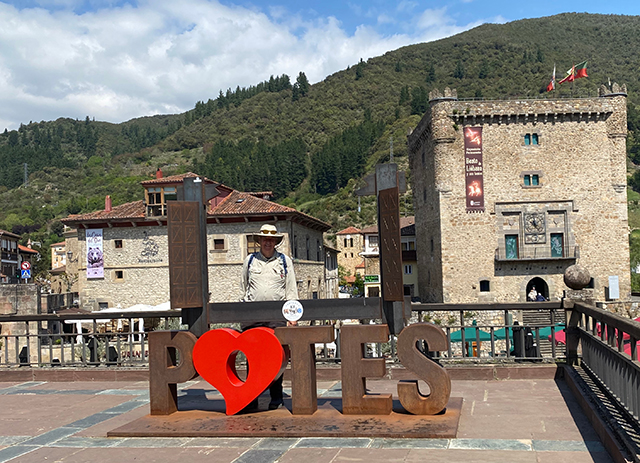
Tourist in front of castle..
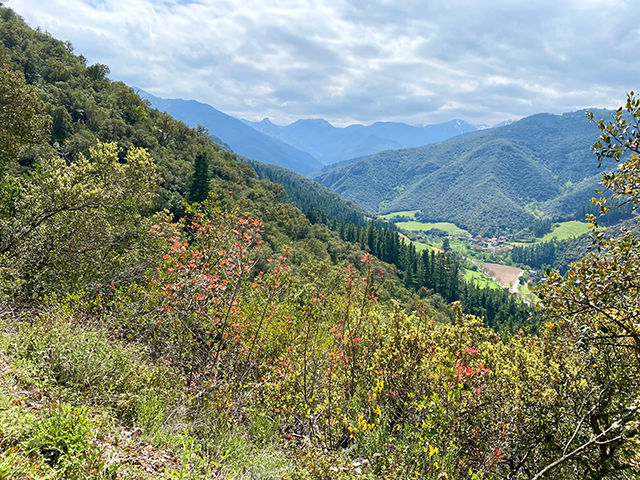
Good bye Potes! (See it down there?)
We will arc up and down a couple more mountains at the 45 degrees you see in this picture. The altitude graph below is deceptive, but still helpful. See those little wiggly lines? It’s lungs and legs, repeat, lungs and legs.

This forecast for our trek comes in an odd shaped green notebook that MP has room for….dangling preposition.
Later today, spread out on the path from the others, I find myself in the midst of an empty village. (They turn up in 15 minutes, ahead of me, just around the corner.)
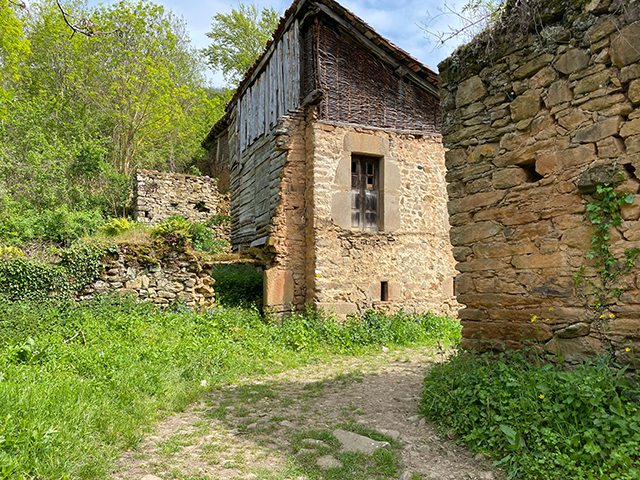
Hello Porcida, a pretty little village completely abandoned. A “For Sale” and telephone number is scrawled on a beam over one of the doors. Great fun to imagine this place alive and restored. Only a 6 hour trek from nowhere. It may take a while to promote, but looks like this guy is trying it on… about to move in?
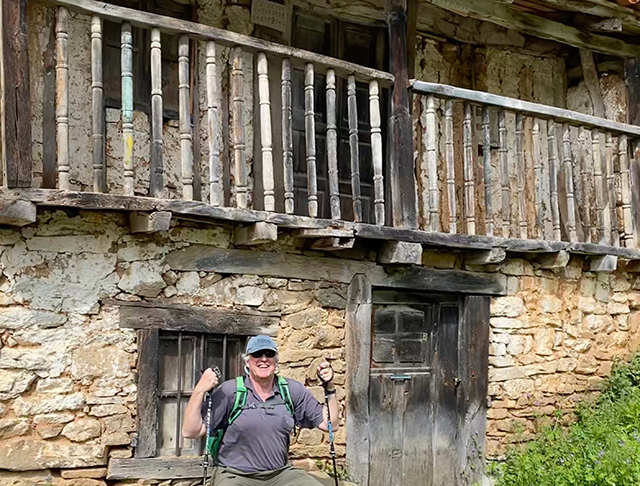
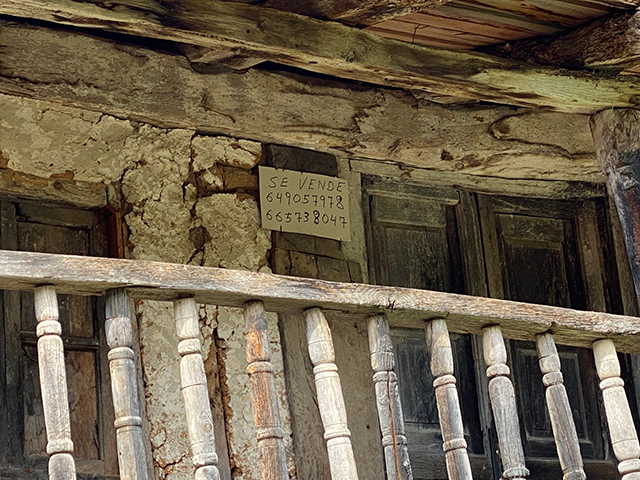
I will spare you the day by day blow by blow of every step I took. But there comes a settling in, a rhythmic pacing between steps and breath and the brain on a long trek. All systems in the body stay in motion. It is actually very soothing, meditative.
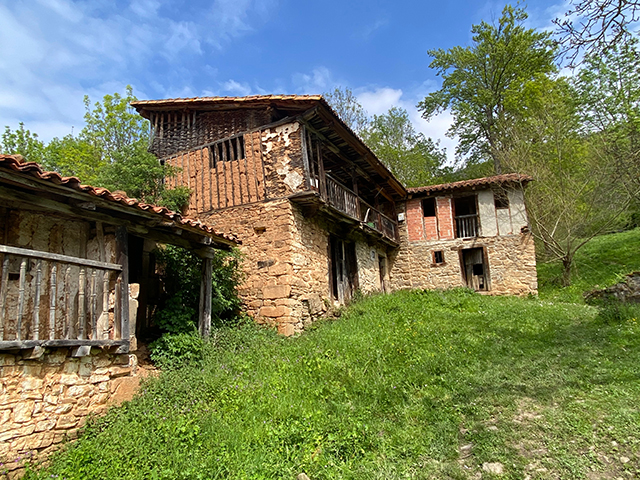
We are each keenly aware by late afternoon that we must cross the town of Tollo before we arrive at the Casa for tonight. It is a very long 3 more kilometers. We are simply thrilled to be at the second inn after a first hiking day. Bags arrived! The hostess is effervescent to see us. Mui candsada, si si. Her gardens are lovely, manicured, but it is still very early for blooms. We are So tired I have no pictures. We are the only ones staying here, the first of the season. except at the parador.
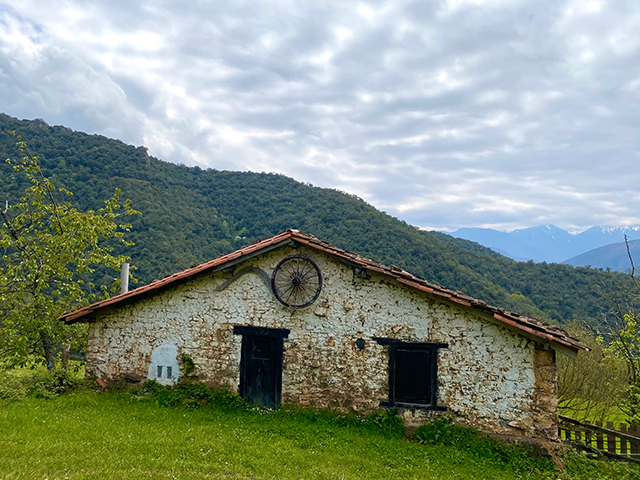
This low brick building was a monastery according to a sign we find on the other side of this valley where those dark green trees are….farther down the path.
The Wikiloc app downloaded to each of our cell phones drains their batteries, but in the mornings, it usually works pretty well, hmm, or until it turns itself off or it looses the trail!
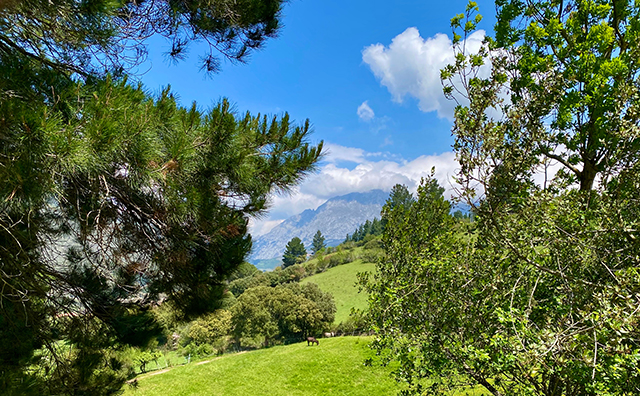
Day 2 Tollo to Casa Oso turns into the longest of the trip – especially for me! To start, we spend an hour trekking back and forth losing the trail right out the front door of the posada. Later in the day, I end up way off course. While chugging up one more extra “mountain”, my back pocket sounds off. I hear “you have lost the trail!” My app had shut off, then turned itself back on. So, with a few grumbles, I find a short cut I remembered passing that drops straight off the mountain back down a goat path to a ridge to a lower path.
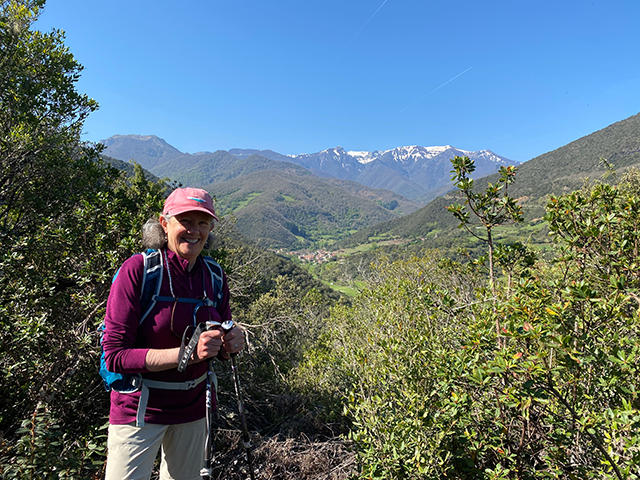
Ellie in the morning identifying more plants..
Meanwhile, the other 3 stop for lunch, enjoy a nice 30 minute rest. Michael texts me while they decide to move on instead of wait any longer (our basic agreement). They come into their next village where I have already arrived, found the ubiquitous water trough, learned from a local farmer how to disconnect the faucet to work the spigot for the best water. My very tired feet are up! Sandy and Ellie are so surprised to see me that they don’t recognize me! It will not be a long rest. Soon I resume my slower paced zone at the back of the line, but this one was luckily fun and funny!

These old sign posts show up on occasion offering a little history about the trails, if they are still readable. Many are badly weather worn. Luckily we have other resources!.

This is the District of Liebana or Lebanon. Peoples here cooperated with the Basques, never assimilating with Moors nor the Romans who they fought off for decades. It is their sheep trails and cork trees we see. And their farms. What an experience!

Most villages have asphalt roads now over ancient rock walled thoroughfares.
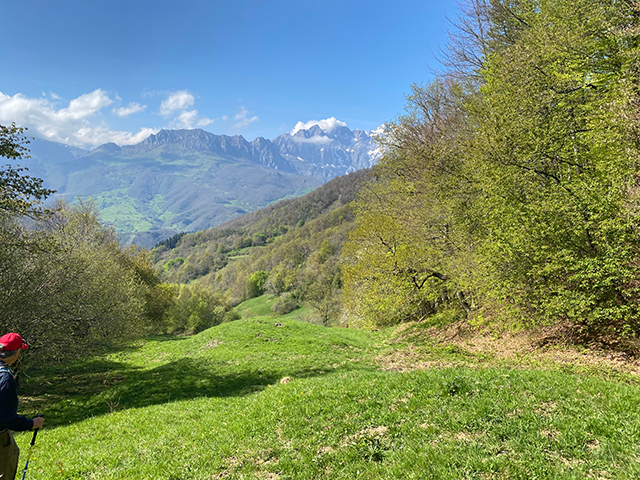
Stay to left on the field?? resume trail at the barn at the lower end of field…
This glorious view belies the incredible end-of-the-day descent down, over, across the “last field” on the trail. They said it was “not marked”. By contrast to what it looks like, our steep zig zagging boots waded through pot holed mud and poison oak. Cows hooves settle sink into this soft turf. How strong their legs must be. Michael’s foot disappears up to his knew, he looses his boot! Mine is almost as bad to my ankle. We are a muddy mix by the lower left of this pix.

It is 2 hours later when we trek up to the front door of Casa Oso, the nicest hotel I have seen since Bilbao. I hail a bellman who quickly finds us a plastic bag for boots! We are too late/tired to get a swim, or play tennis (!) but find plenty of time for a good hot shower and a meal! What a day. We sleep with windows wide open to hear a river rushing by. We will be crossing that bridge tomorrow. Until then, Thanks for reading!
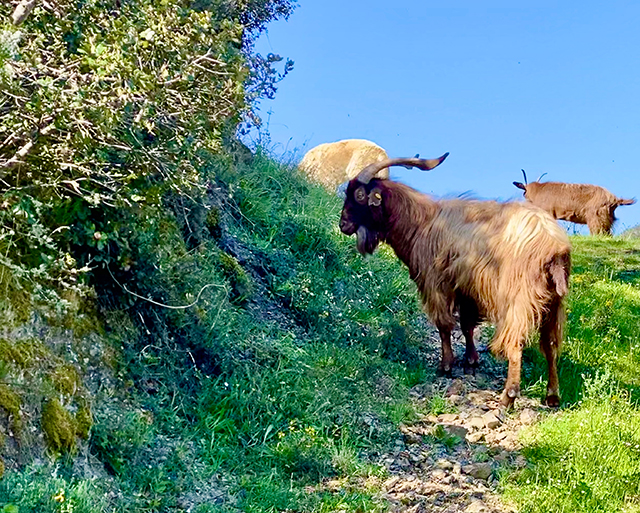
All sorts of company on the trails – no other hikers in either direction….
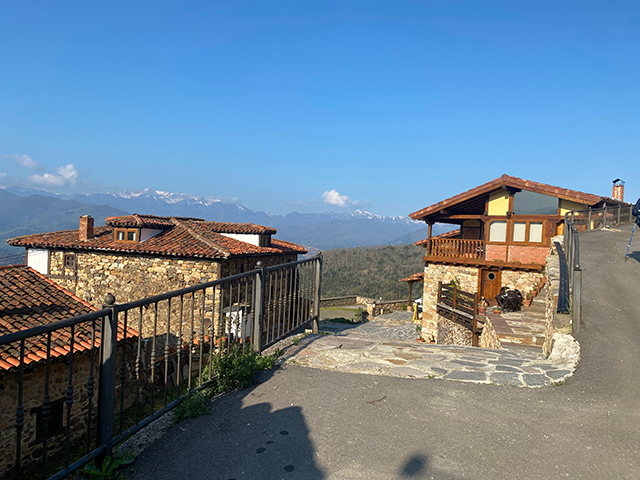
We drive from Bilbao to the inn at our first trailhead in the town of Cabezon. The freeway from the city turns into a narrow road meandering along a river between an uneven railing and a stone cliff that almost scraping off the rear view mirror. Alex, our guide for the drive and “orientation” manages to maintain a breathtaking speed on these, his, roads. “I’ve lived in these mountains my whole life. My kid goes to a little school with not to many others and my wife…” It is raining. We don’t see any views, but the inn keeper is all smiles. We are the first trekkers for the season – May 1st!
Alex sits us around a large table in the “bar” opening up two large topographical maps he had for us to carry. Orange marker lines highlight our trail. There are a couple of “extra optional routes” in addition to the 10 miles expected each day. Maybe not, I think. The elevations are spelled out in a small wire waterproof (luckily) booklet one of us will carry. We expect 2300 meters up, 2600 down, not all in a row. It will be up, down up, down. Can we do it? Well, here I am. I am glad to say now – yes we did!
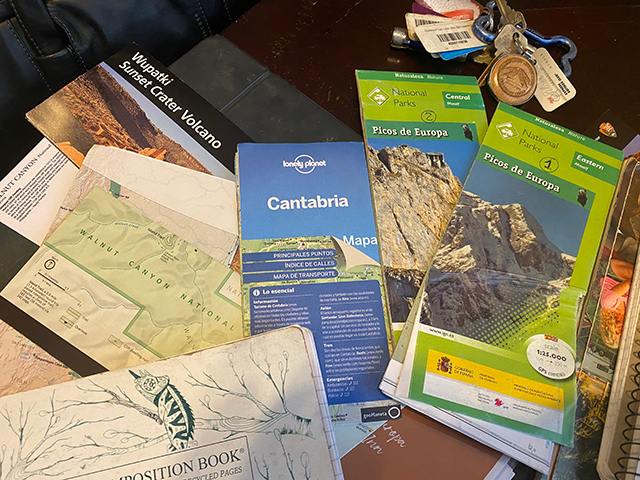
Alex isn’t done yet. He brings out his own phone, opens to the app he emailed to us for our own phones to download back when we had strong wifi in the city. (I have the wrong app!) He tries to explain, but hours later we are/I am still heads down. Patiently Alex takes each of our phones to set them up. My wrong app has recorded my “trek” since I left Bilbao. I have gone 120 miles. All my local trails are gone. I turn it off, delete the app, reload with name and password. Oh I am tired now – for sure.
Our first meal, we choose the “typical local plate” as Sra smiles gently, again. After a yummy salty thin noodle soup, a huge plate of garbanzo beans with pieces of cow bacon , stew meat and sausage arrives for each of us followed by a big bowl of flan. The red wine we order washes it down – and lots of water right from the tap. Anything green here? Chalk it up to carb-loading.

Our luggage will travel first class on this trip – inn to inn; it’s an option to join them.
By morning, skies are clear to reveal snow capped ranges in 3 directions right from the futon feather bed. Hikers have stayed here for 30 years with Lucille,I learn her name by now, the proprietor, a grandmother, offering dinner at 9 and breakfast at 9. She runs the two story house as if we are family who will all be here over holidays.
For breakfast, as we are eager to get on the trail, Sra. is flexible, serving us by 8:30. Toast, white cake in packets, apple fritters with sugar that look like curled pancakes and thin coffee. We fill our water bottles from the tap to wash down more carbs.
Our boots newly tied over new socks, hiking polls out of the suitcase with day packs carrying extra warmth and rain gear (for good luck), sunblock, hat, etc. etc. I wear a waist pack – no shoulder weight for me!
Ready, set, GO!
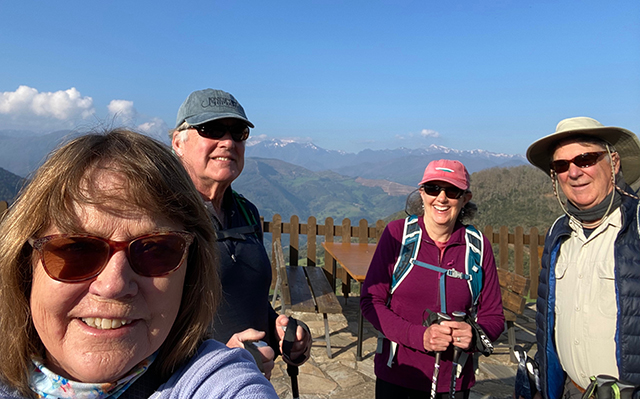
OK – a selfie! Sorry!
Trail out of the town is really beautiful climb to a long stretch thru fields and forests.
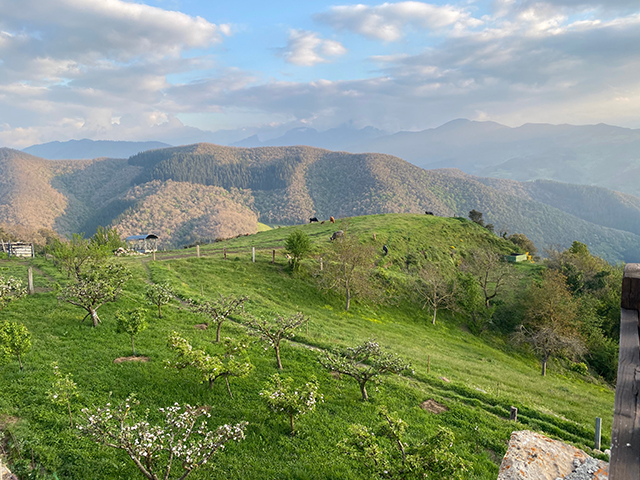
Hard to leave this first farm – all of this belongs to the Sra at the Posada.
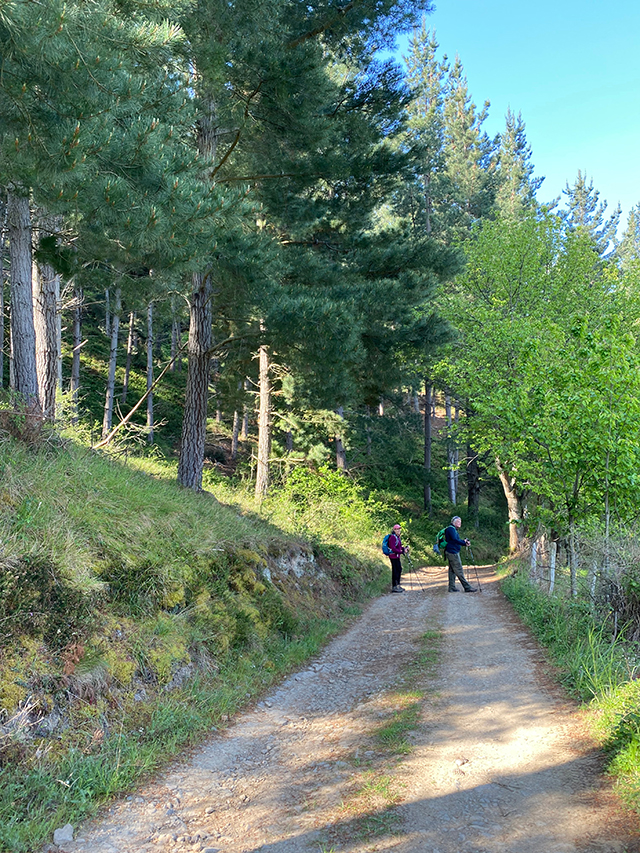
First day – finding heather growing along the shepherds’ paths. Ellie & Sandy check out flora and fauna everywhere. Gentle start.
All sorts of farm animals along the way, but rarely do we see any people! Cows and horses wear thick leather collars with cow bells that resonate across the fields. Soothing.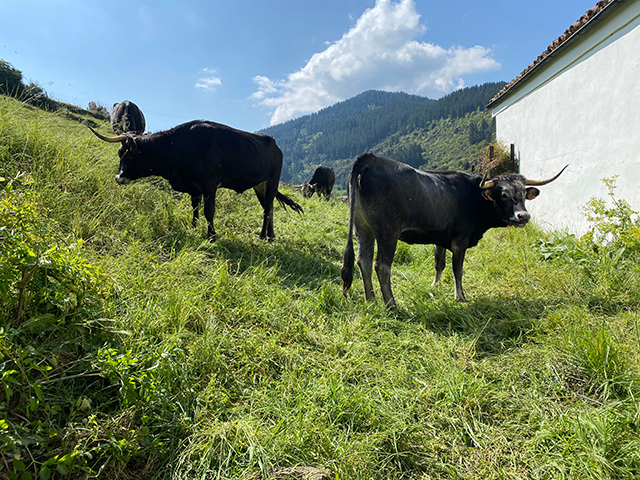
All week we find the fences & gates are rewired plastic rope that tie to something!

At one turn, we find goats, too, including this large male billy goat with horns in the shadow on the lower left! He is just as skittish as his family, so there is no issue.

Large goat on the left (looked like a yak to me!) is the billy goat, luckily very shy!
Sometimes a cow or horse will come up to their fence for a short conversation – I wish I had a full pocket of carrots! (for me, too!)

Still in the field in town; maybe a dozen calves with their mothers here.
We are in Potes actually earlier than lunchtime (2 pm!) but Casa Cuyo takes us in, serving us a drink, then at the stroke of the hour, out come pre-ordered salads. An unforgettable meal. Energized, we focus for a long haul to Casa Tolle – posada dos!
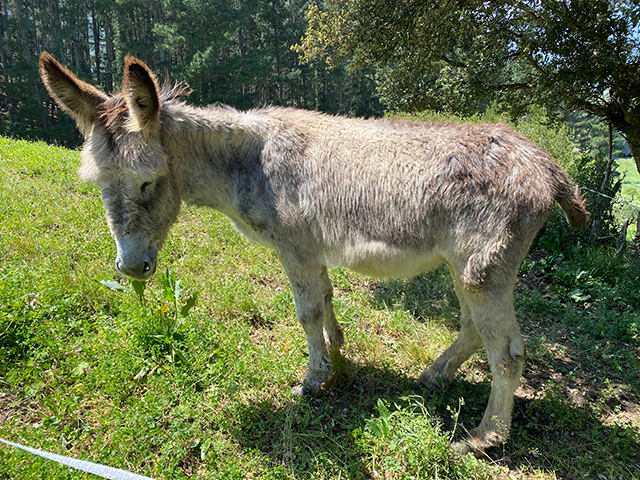
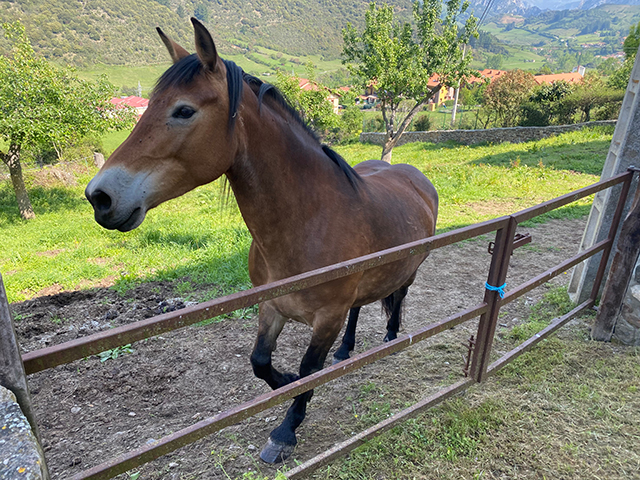
What a trip this has been! Inn to inn for 8 nights with 2 extra in Bilbao & 2 more in Santander on the northern coastal beach!
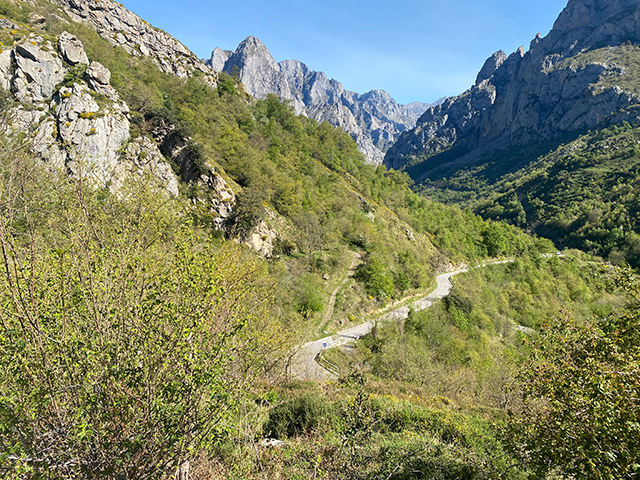
Our trails will weave through 3 provinces and the Picos de Europa Nat’l Park, thru villages, farms, and ancient shepherded paths.
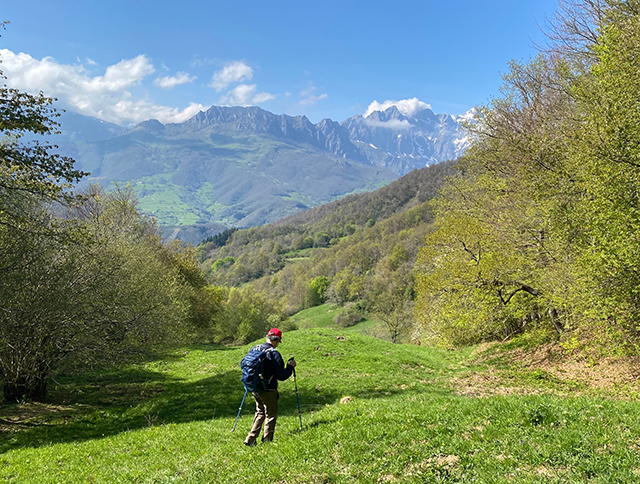
From Home:
I’ve been back from the 8 day hike in Northern Spain for 2 days. My sense of time is readjusting to the 6 hour difference between there and here as load after load of trekking laundry circles the machine cylinder, zippers clicking, wash water swooshing, and hot air humming through the dryer. Stacks of mail fill the dining room table. The frig is basically empty; maps, notebooks, and travel receipts lay about inviting me get organized, pull together a story, create some sort of record of the tour: a trek through three northern provinces of Spain: inn to inn on shepherd trails used for centuries by Basques peoples.
The area we explored includes the simply stunning Picos de Europa National Park south of Gijon, north of Santiago de Compostella, and west of the two cities we will explore: Bilbao to start and Santander to finish up.
OK, Here we go:
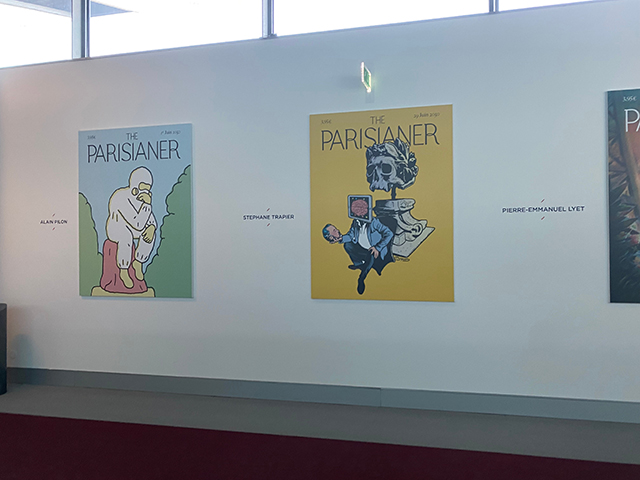
artwork hanging in concourse between connecting flights …
Connecting through Paris, we find illustration art in the airport halls – imaginary magazine covers for a fictitious 2050 publication! a nice diversion. Our flight to Bilbao will take less than two hours.
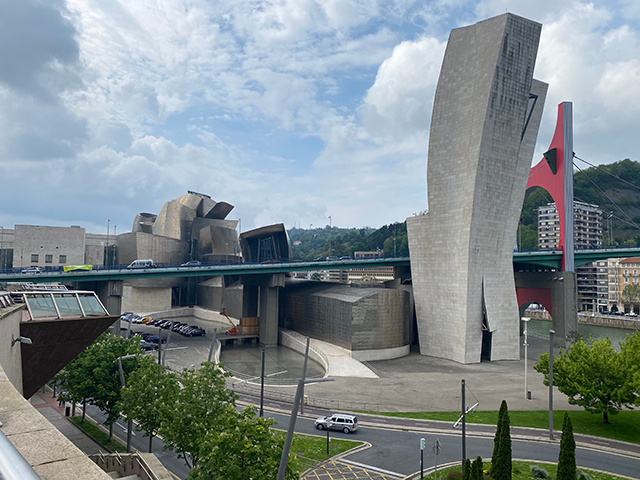
The Guggenheim
The Guggenheim will be the first thing we see entering the city. The Hotel Miro is perfect: meticulously clean; directly across from the Frank Gehry masterpiece (1997), and only three blocks from the Belles Artes Museo, reopened after multi year renovation. We schedule breakfast, included, so we won’t crowd the dining room.
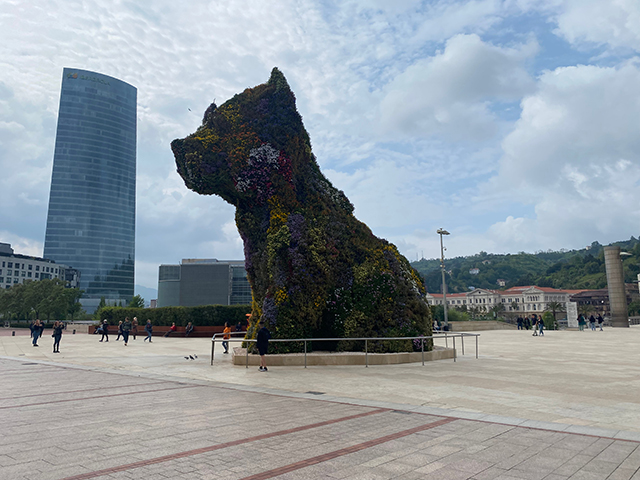
Views of the Jeff Koon’s sitting “Kitty” created with flowering plants looms in the entry plaza where the light, the number of people, the energy changes hourly.

Lovely parks encircle the museum. The exhibitor this year is “Motion: Autos, Art & Architecture”. Popular for all ages and interests, I have pix of all of the galleries.

Designed in 1930’s this Bugattoi was never produced commercially. Stunning!.
Richard Serra’s cast steel installation provokes exploration. The room is huge!

The building actually seems to resonate through the day, reflecting shadows, sunshine, rain drops, night lights. We see them all in our 36 hours here!
Springtime in Spain!
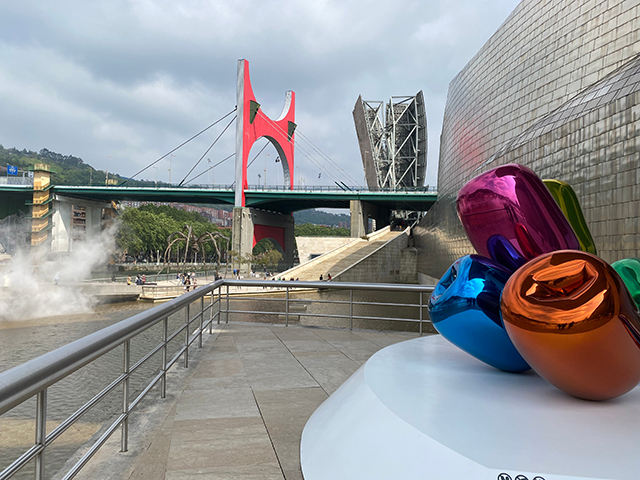
The trip is a first post-pandemic rescheduled tour planned in 2019 for the four of us who then wanted a hiking excursion. Now, years later, we knew not at all what our strengths would be nor how our 70 something energies and abilities would react to time change, to new foods and unexpected travel challenges and the big question: could we do all the treks – 10 miles per day. We spoke directly with each other about taking care of oneself, not competing and yes, enjoying what ever would unfold. We are: Michael, who I think you know is my husband; his first cousin Sandy, (their mothers are sisters) and Ellie, his wife. We do remember being married about the same time, but our lives have not overlapped , except on rare occasions when those mothers coincidentally invited us all in town at the same time.
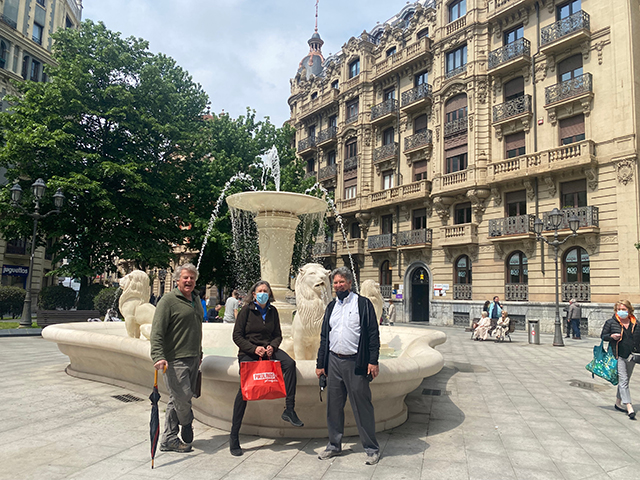
The first trek turns out to be through the city of Bilbao. We refuse the idea of a taxi! We step count in preparation for the 8 days of trekking. Ellie and I find the Spanish shoe chain store, Pikolinos. We do enjoy a nice, too nice? restaurant the first night, but find the 9 pm dinner hour, strictly observed, a challenge. We overcome an overcharge by the waitress; correcting the bill the next morning with the Manager.
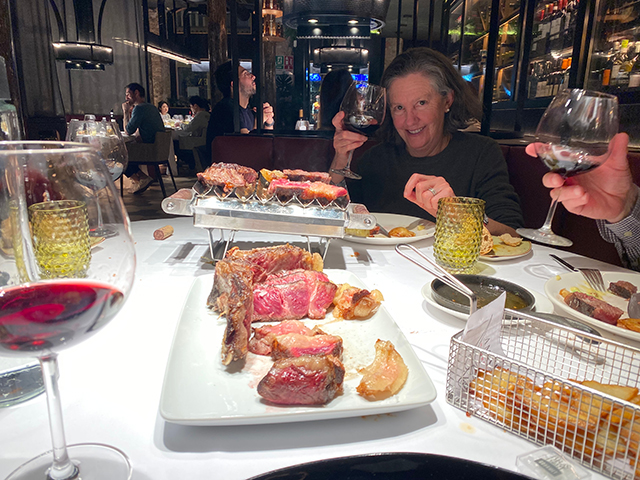
The meat arrives barely cooked; the zig zag silver tray is a grill right on the table!
Our way to cope tomorrow will be tapas! Viva tapas!
There are infinite great views to find in Bilbao. Sculpture everywhere: bridges count!
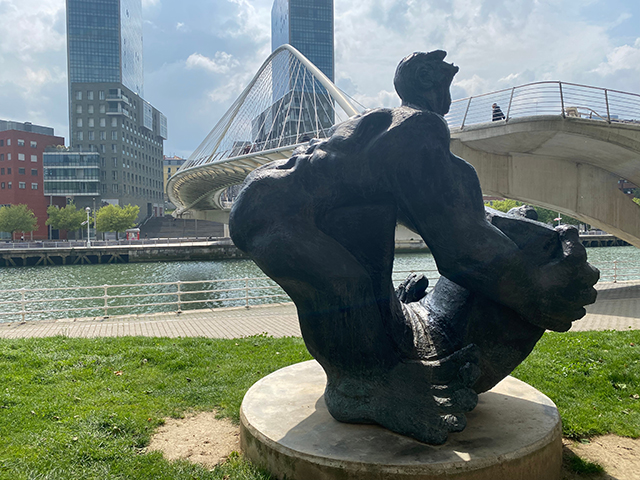
We walk so far that Sandy gets a sore leg from the hard pavement, and on a long stretch of a staircase, Michael knocks his hand into a bannister and mildly sprains his finger. This start could look better.
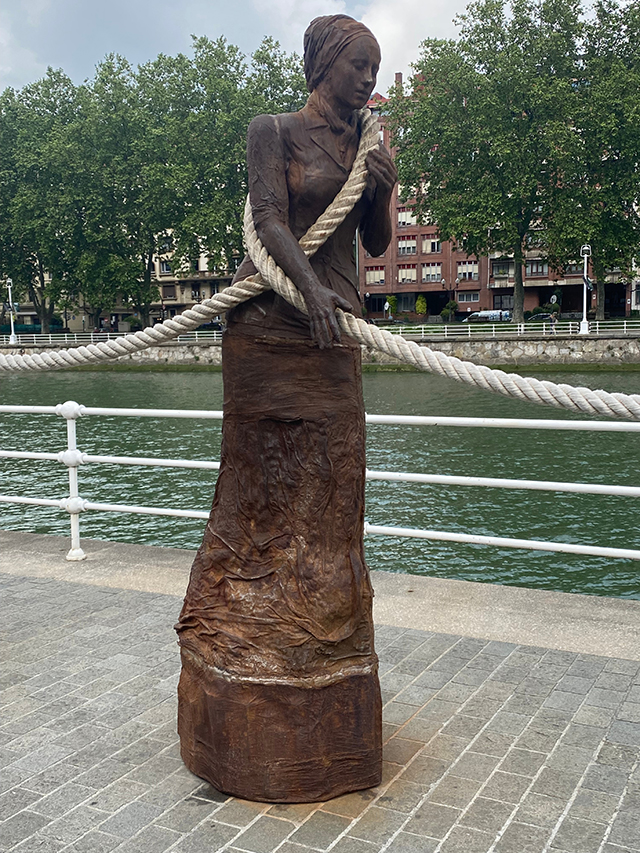
This woman is one of 4….always people posing around them……
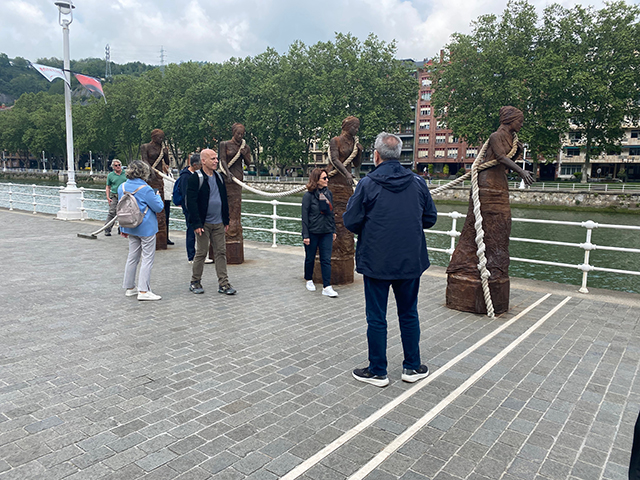
We find all sorts of historic buildings, including the opera house in the old town and aim for a new view, the Library to find an impressive auditorium on the second floor and a display of authors who are 100 years in 2022. This includes Virginia Wolf!

Simply beautiful!
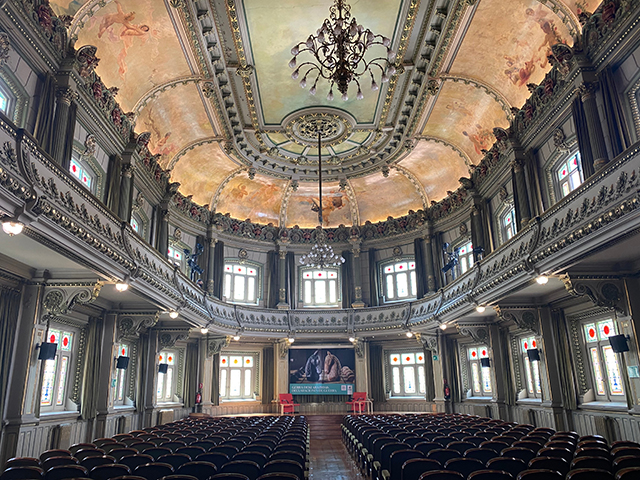
I haven’t even started on the trek! Oh my. I’m out of steam. It’s time to take another nap! Ahh. Time change! More to post very soon.
Thanks for reading.
Ramelle
The trip has its moments, as all do: the ups and the downs; the wins and the losses. Some elements are going smoothly on this second cross-country haul with two dogs in the back seat of an SUV that can pull a 20-foot Base Camp Airstream trailer.
Michael can hook up the rig and attach the ball to the cup, engage the brakes thru a Bluetooth connection and complete the hitch. I know the way to store food in the small frig and lower compartments. I anchor the pots and pans in dish towels and prep everything in the camper kitchen for the rock n roll of the rig on the road.
What’s new on this return route? It is April, not December. We have light until 6:30 or 7:00 pm. And we have warm days. On the first and second day, we find ourselves crossing the California desert in 98-degree seriously rigorous conditions. Evenings are dry and cool, but mid-day takes endurance at Joshua Tree National Park where dogs are not allowed on the trails and we can’t leave them in the car. The trails are busy with eager hikers. The park rangers are able to be cheerful and helpful in spite of so many visitors. We arrive mid-afternoon in a place called Salome AZ, a second flat land, sparse desert stop where ATVs cruise through sagebrush along miles of dirt trails. We could press on, but decide to wait it out through the afternoon hours, test the AC in the camper, use the Rv site’s swimming pool, and clean shower. Everything, including poodles, gets really dusty from the 25 – 35 mph winds that are a welcome buffer to this heat.
Our morning departure takes a bit of self-negotiation. On the one hand, the WiFi and cell service are strong enough to sit in the coolness of the quiet desert and catch up on the world. On the other, the quicker we get out of this place, the better because the heat is coming. Get going!
Good-bye Salome, Arizona. Note: we were here! We did not see a soul driving through the town on Rte 60. Gotta love Rte 60. It is in great condition, even though Rte 66 gets all the attention. Empty desert. Beautiful in its subtle undergrowth, but scary and dry. I expect that life is lean for people who live here. But I don’t know. I don’t meet them.
We are avoiding the I-15 traverse from Barstow to Las Vegas. It would be more direct, To reach our cross-country interstate route I 40, we make the diagonal traverse through Prescott National Forest of Arizona to Flagstaff for another 2-night stop.
Weather will dictate whether we make the trip straight across or turn north sooner onto I 70 – that would take us through Kansas City and St. Louis.
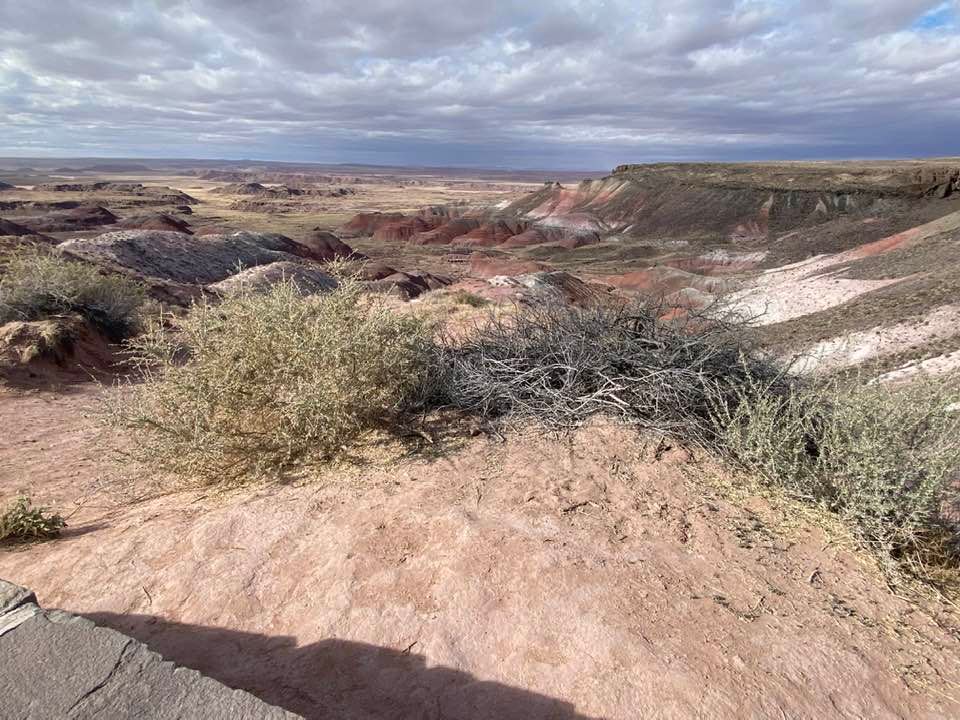
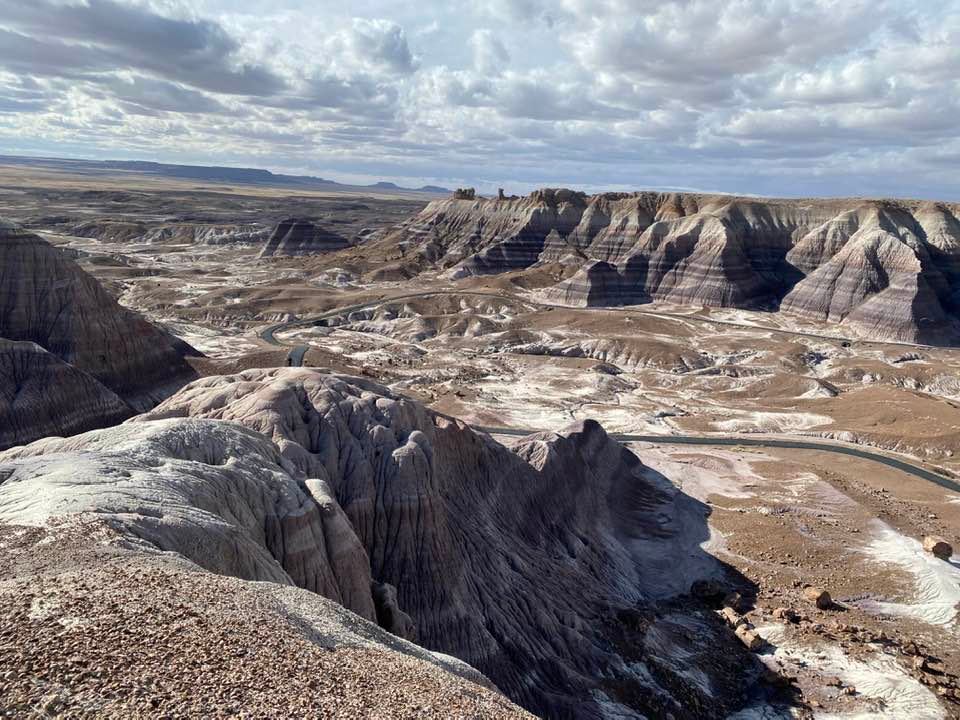
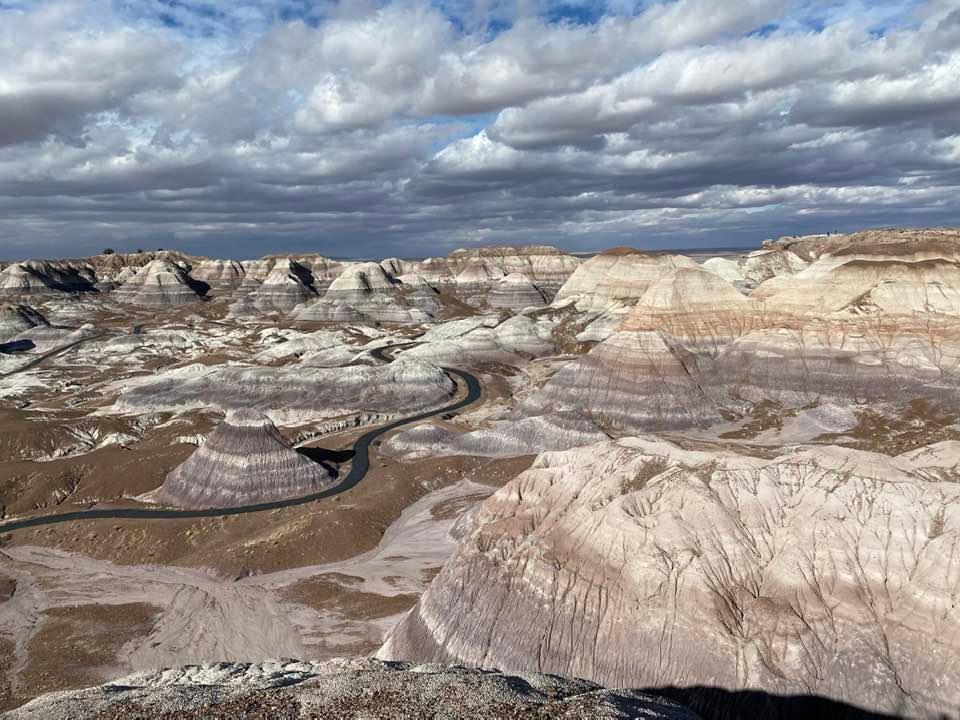
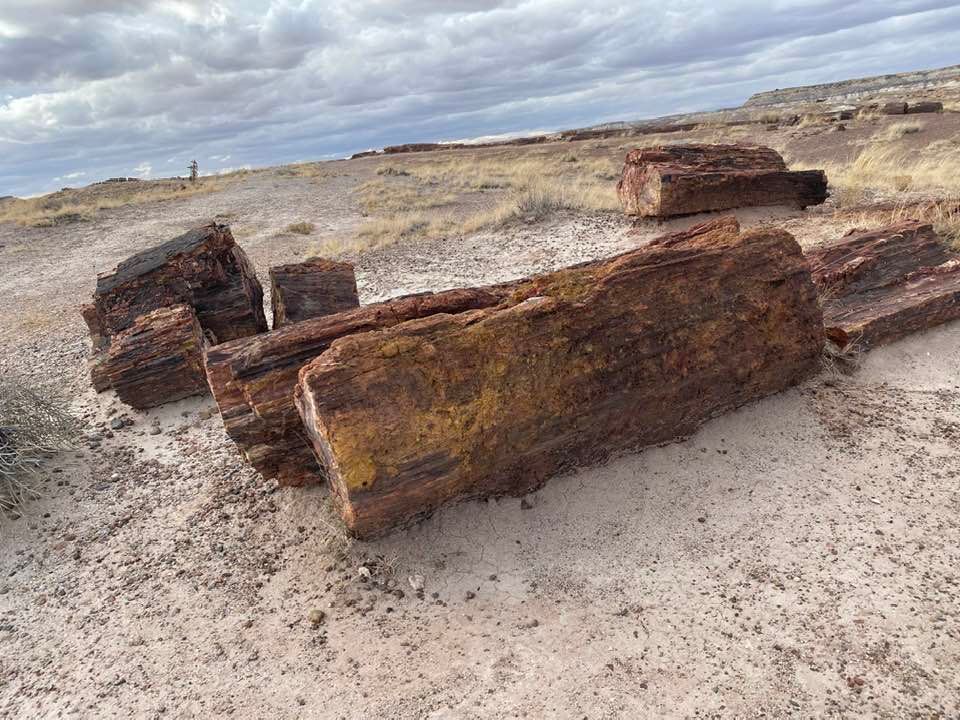
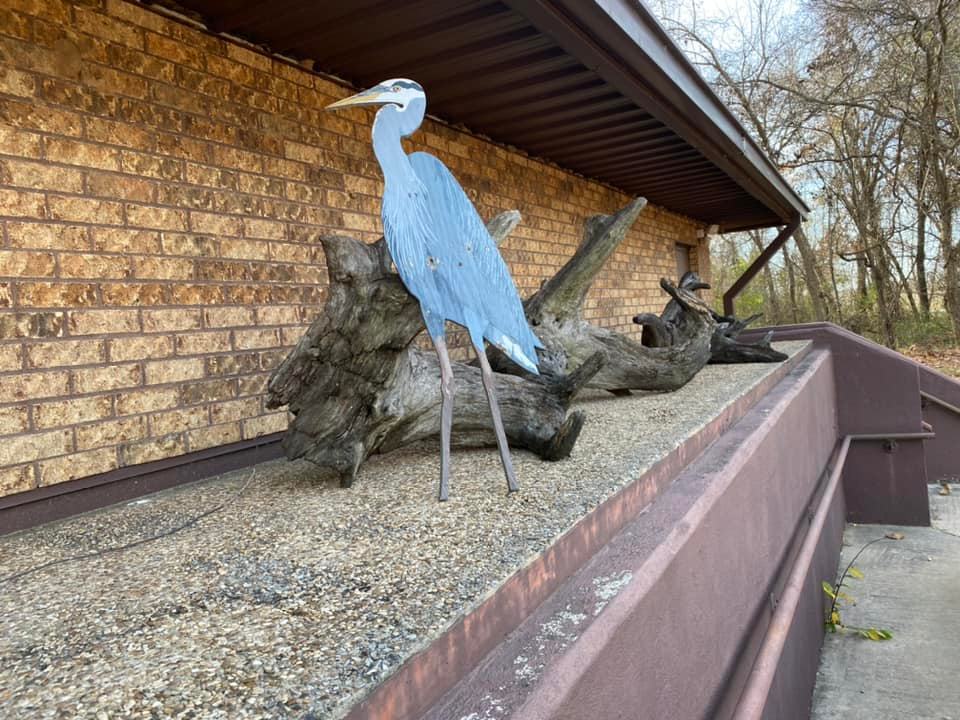

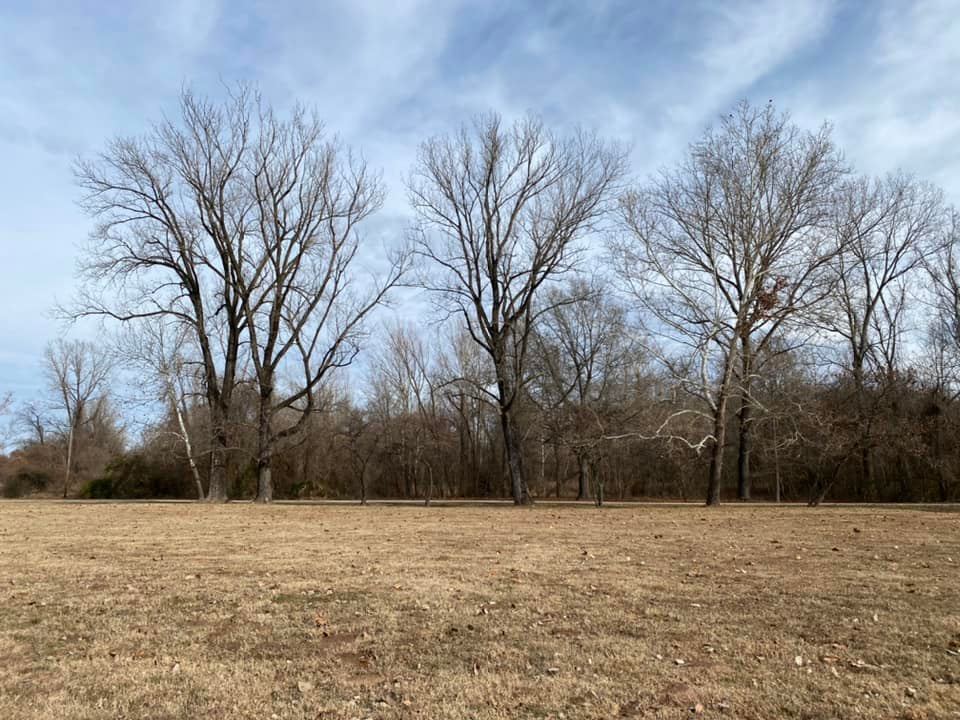
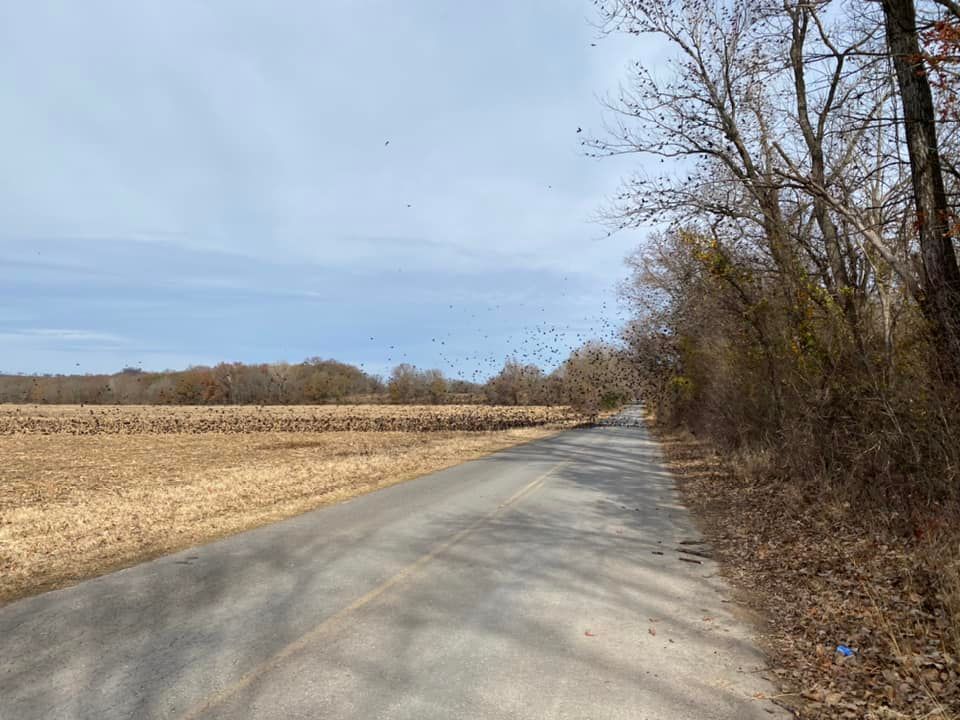
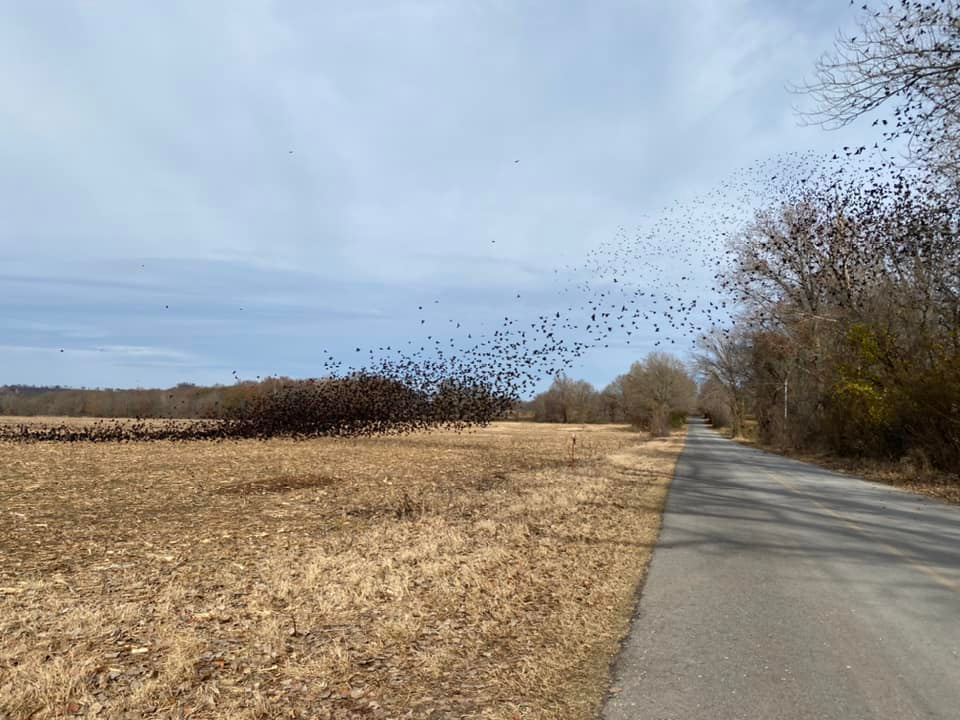
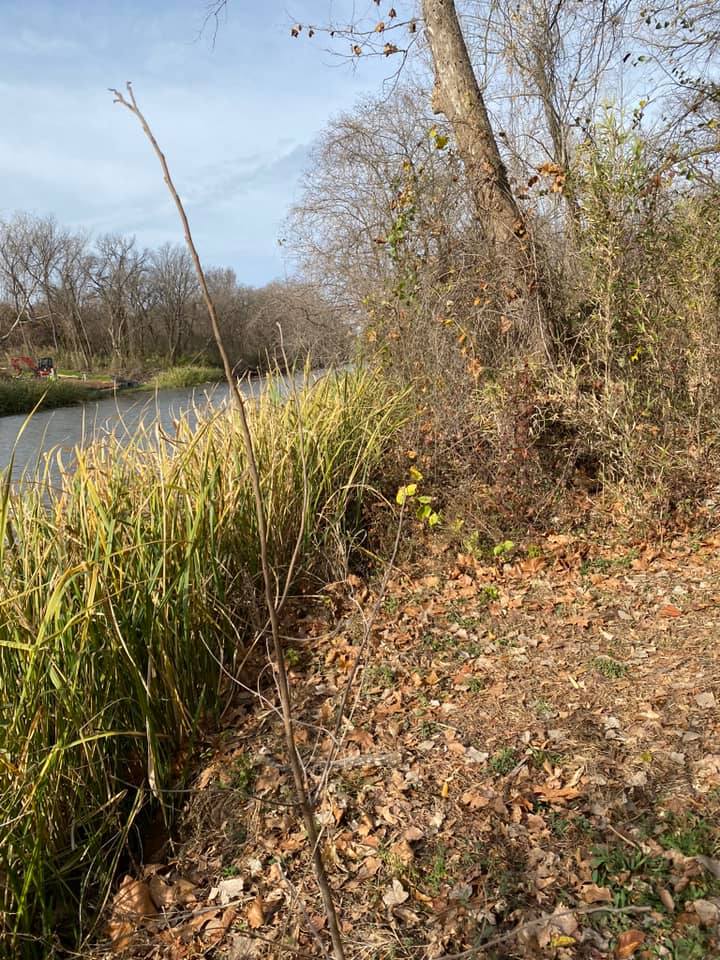
As each of you mentioned you were curious about this trip! So, here I go with updates on our travels from MA to CA that start out on 12/1. I’ll carry on until 12/10 or 11 or 12!! As I am having trouble figuring out an email “group” in my “contacts”, this is a blind copy to each of you. Feel free to share with the friends we share – only!! And just let me know if you’re too busy to bother with these notes now by sending back a note “I’m busy”.
So, it is Friday, December 3 – Day 3, but I will send you my notes from Day One with any pix I think might be fun. Here we go!
December 1st – 8:30 PM
The first day in this new BaseCamp, now 400 miles from home in an RV Campground off of I-81 in Harrisburg PA. The noise of the freeway seems minimal, though I walked the dogs right next to it. (We are traveling with our 2 black standard poodles: Coala aged 10 female and Bear aged 7 male). The rush of the motors is a little like ocean waves, the exception being a flock of motorcycles or race cars with screaming engines in hot pursuit of maybe nothing at all?
Our route: 23 in MA to I-87 to I 78 to I 81 to exit 322 to this RV Park.
The camper is so efficient that my haphazard packing proves pretty good. Only a couple of magnetized cupboards popped out, but nothing really bad. The pillows and bedding that we didn’t anchor are strewn about. The sleeping bags are still in their netted hammocks conveniently placed for storage along the upper corners of this 6’5” tall space. It’s 20 ft long.
Such an intense day! I am navigating as co-pilot on my cell phone as the new BMW only recognizes Michael and doesn’t understand audio directions from him. Both of us are watching every bump in the road, each descends and turns and lists to test the reaction of the brakes that are computer detecting each other between the vehicles. We want to gauge any reaction of the trailer. Michael is driving well and he’s doing good at 50 – 65 mph, even reaching 70 in short stretches of perfect straight away surfaces. The car is inhaling gasoline! Trucks – 18 wheelers – pass us all day long while we trail those gas tank trucks, the ones that fill things up – canisters, furnaces and maybe trailer parks, fuel delivery vehicles that hug 55 mph in the rightest lane, like us.
The 5-hour drive takes us 6 with 2 stops. Nonetheless, No turning around – yet.
Dogs in the back seat. They’ve been ready to roll watching the preparations for at least two days since I put their bedding in the Basecamp and threw their favorite blanket on the retractable steps into the camper as if to welcome them. We only GET the camper on Monday the 29th, so that we are leaving by Wednesday is feeling like – ah, what the heck – why not The dogs couldn’t navigate the steps to hop into the camper without the blanket that covers what looks to them like a thin ladder! The dogs have no space relationship/perspective to speak of.
It rains pretty hard the first night. It sounds like it through the aluminum can we are in. Even though temps are about 39 degrees, we are comfortable. Because of this gloomy winter story in this boring row of campers of all kinds, I didn’t take any pix….oddly, we meet about 4 – 5 couples who have lots to share with us. Campers are friendly. Campground people answer their telephones. And they are there to show you all about how things work! Sort of an odd mixture of being on our own and knowing we are okay to be here. Welcome? Sort of. ….
PS
Dinner our first night was spinach cooked on the stovetop in the new frying pan and smashed potatoes I’d made up before we left and refried. Yum.
Michael was up with the dogs 2x in the rain. My hero!
We sleep better on night 2. More tomorrow from central time zone. We just crossed over 20 minutes before stopping at this KOA campsite called “Crossing Over, TN” no kidding. That’s what it is called.
Good night,
Rambling down the road…….
Pix of fist day or so….





Center of Ponta Delgada, capital and largest city on Sao Miguel Island, one of the nine volcanic isalnds in the expansive archipelago.

Blue crater lake in the center of the island, one of several.
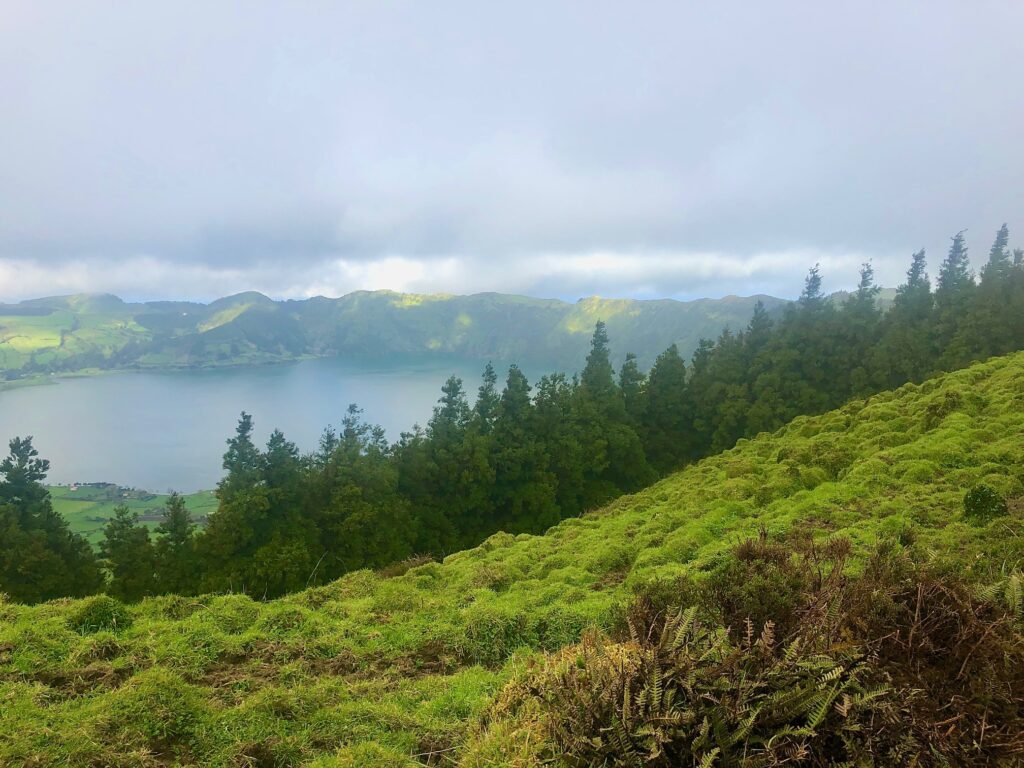
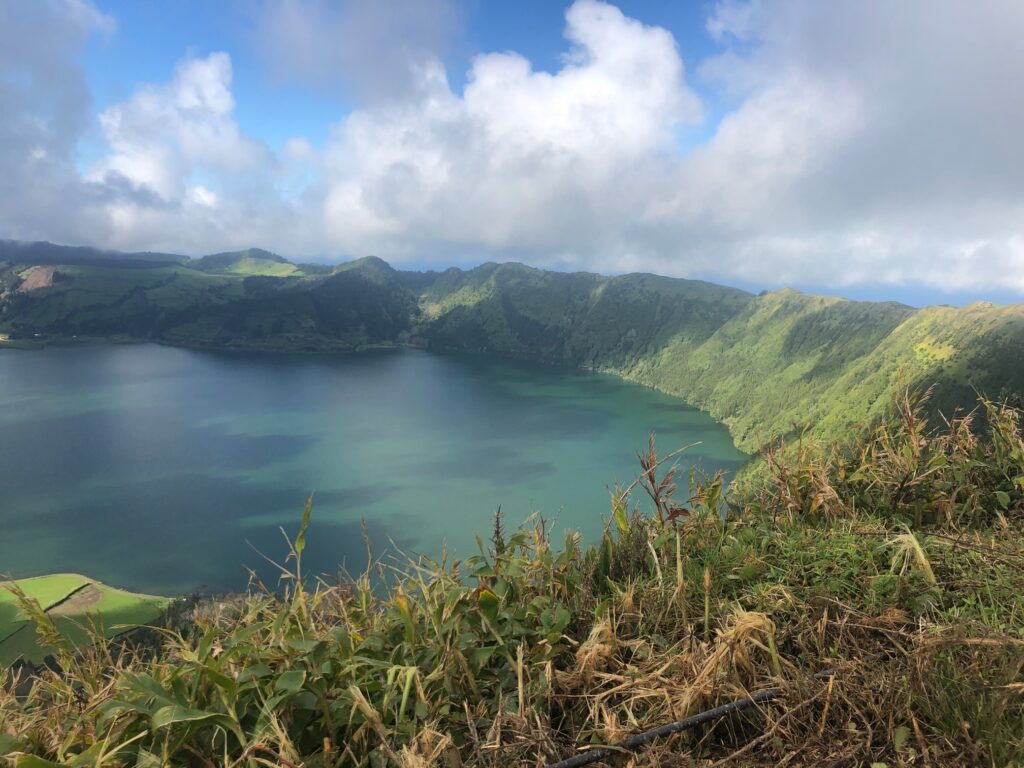
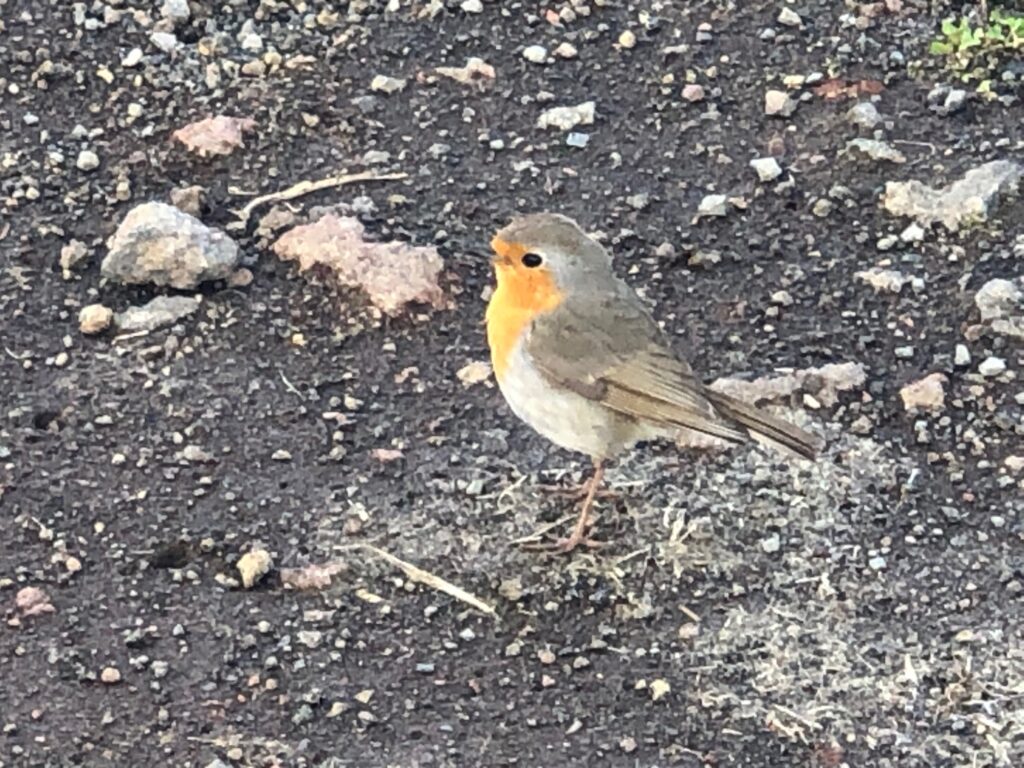
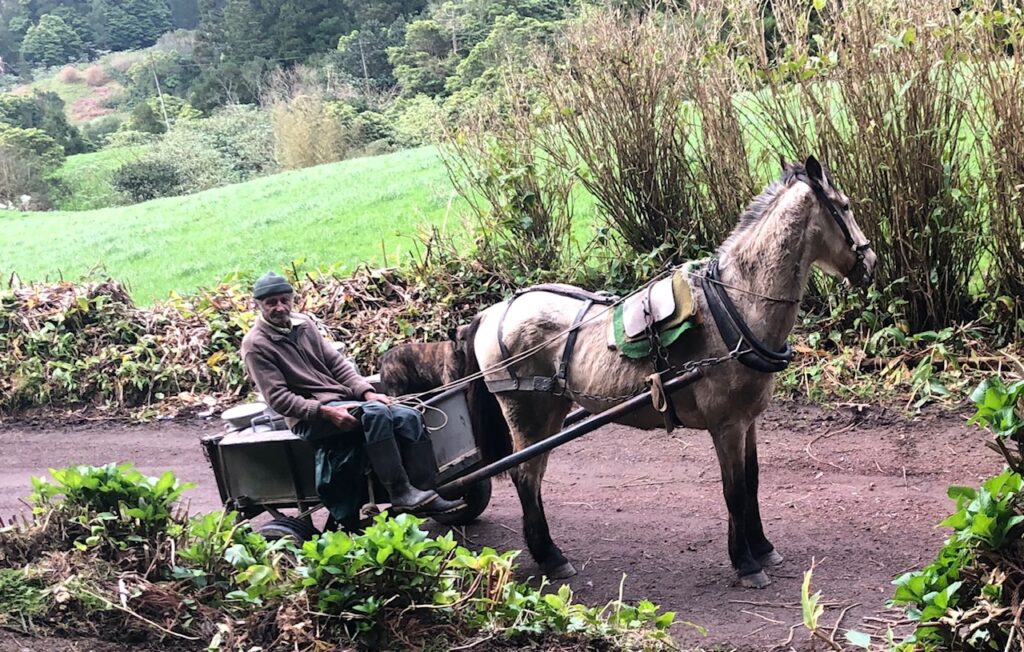
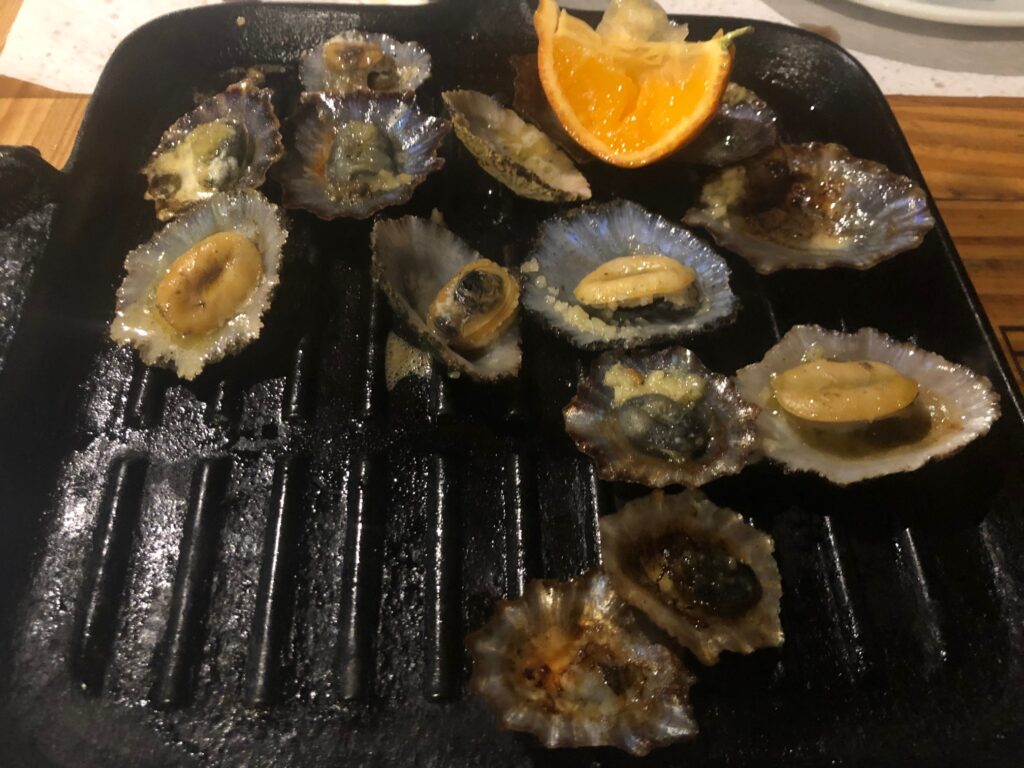
Distinctive muscles roasted in butter and mandarin orange – a local feast.
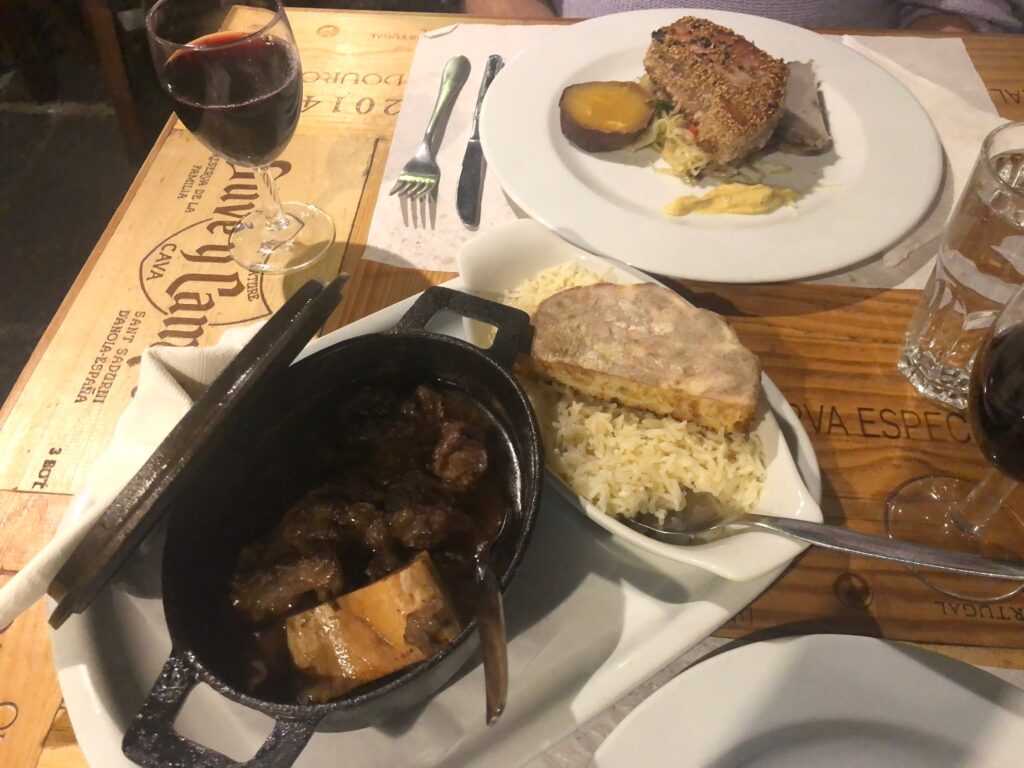
Stew cooked – all day – in the cinders of the volcanic ashes with rice and local bread.
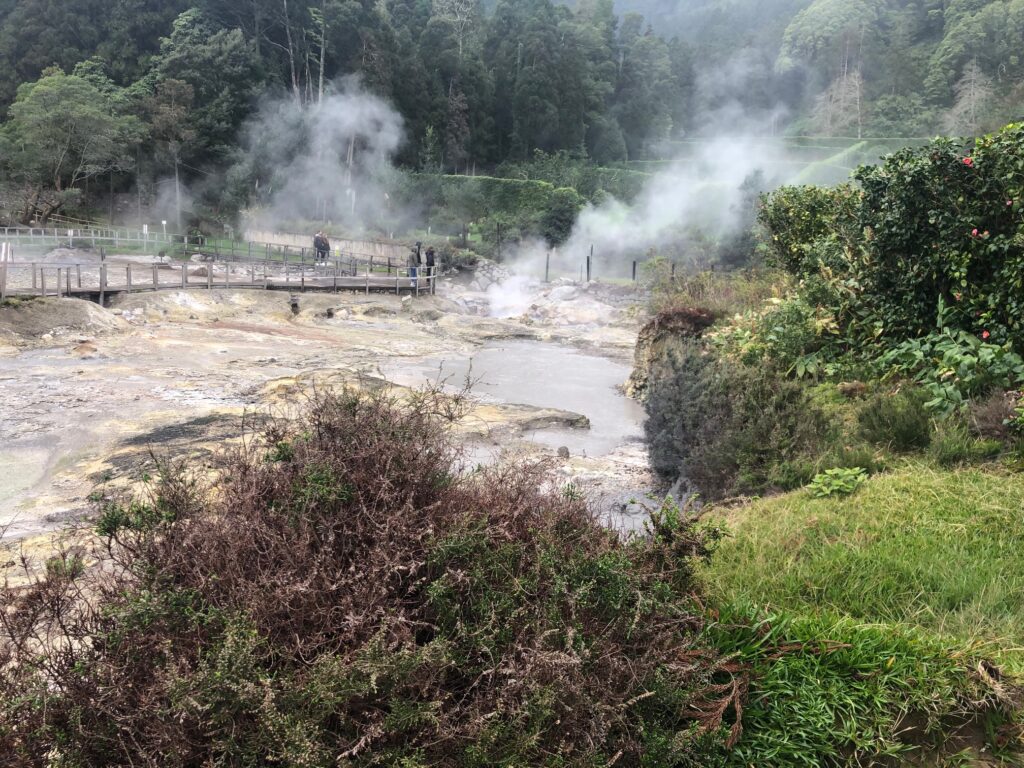
Furnas These waters will run off to hot baths at the hotels.
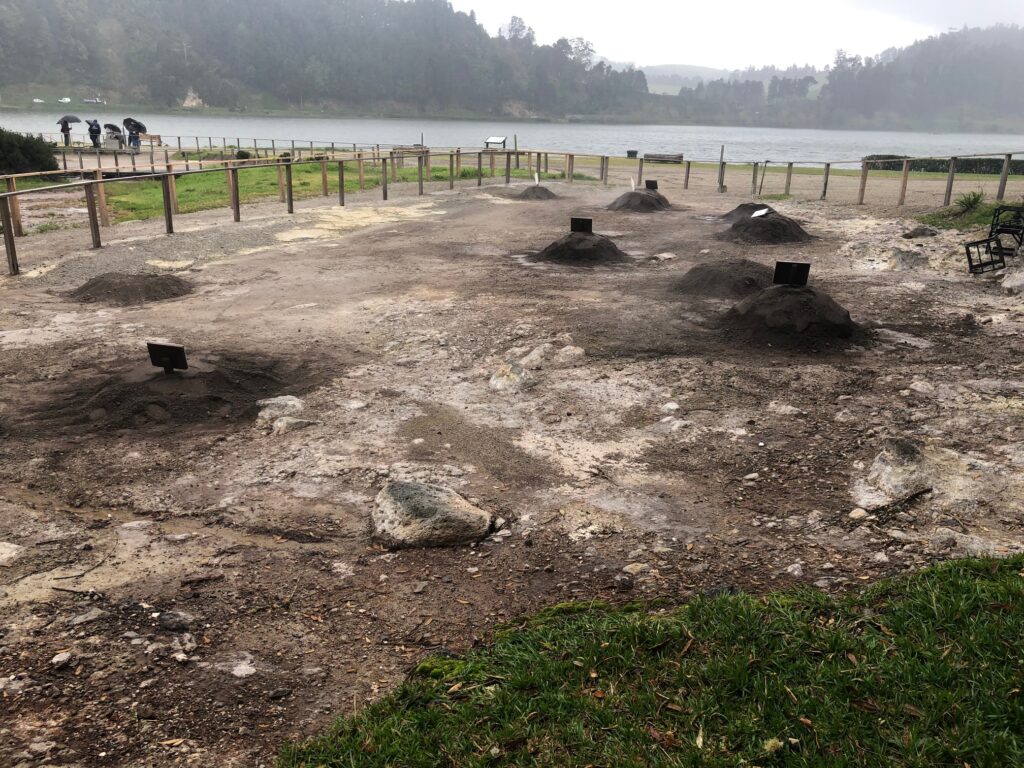
Signs mark the mound of the restaurant who has brought their stew pot for the day.
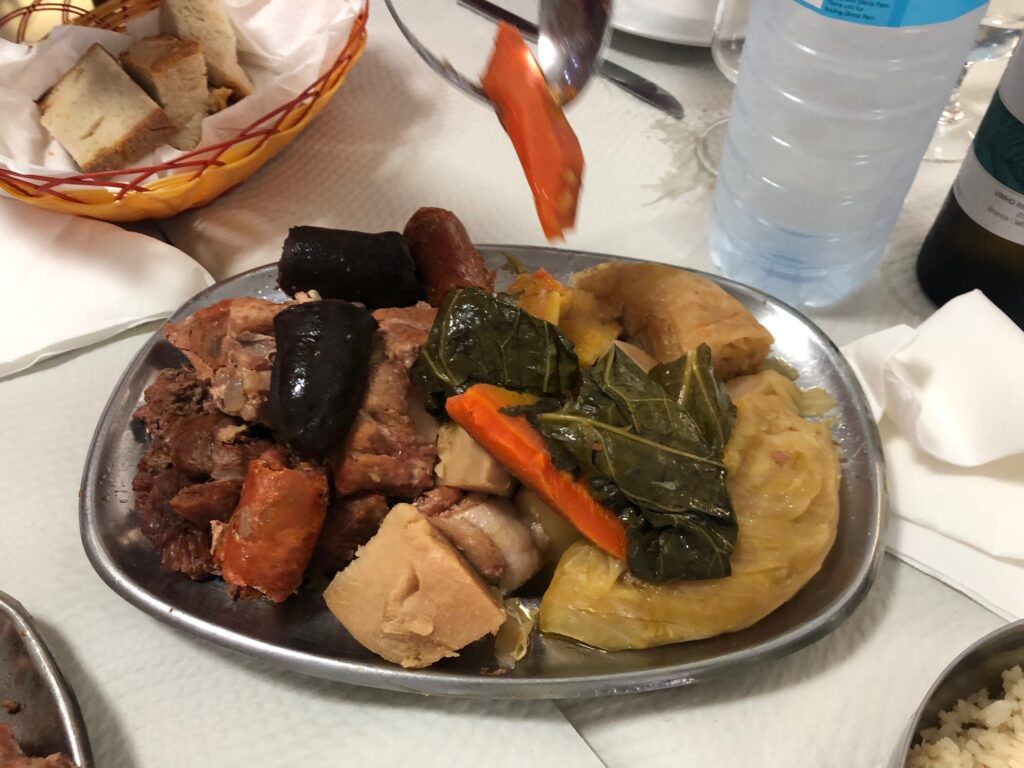
Servings are truly enormous. This is just for me!
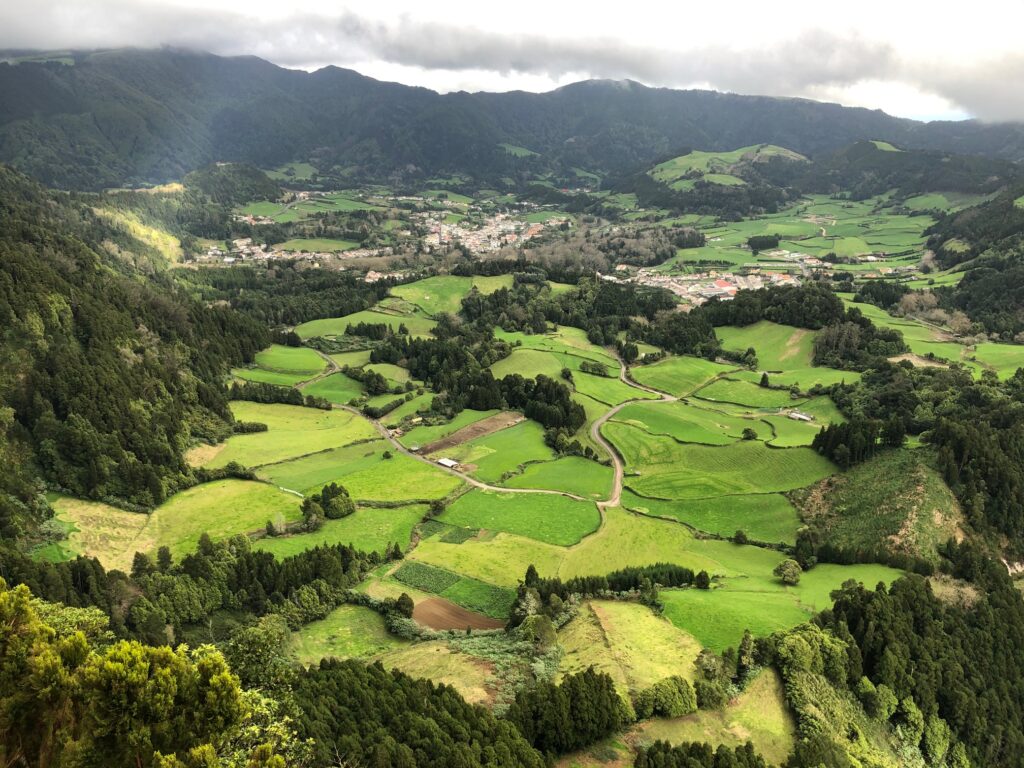
Patchwork fields remind me of Ecuador. Lots of happy cows down there! Milk and cheese made here is distinctive & delicious.
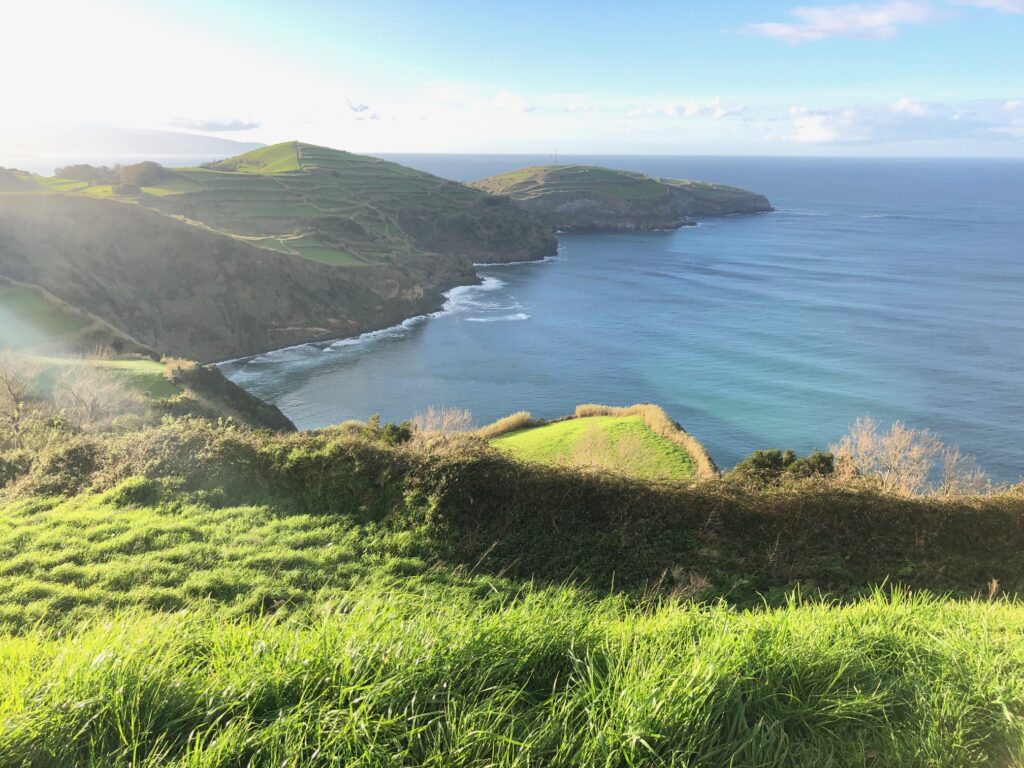
Oceans in all directions
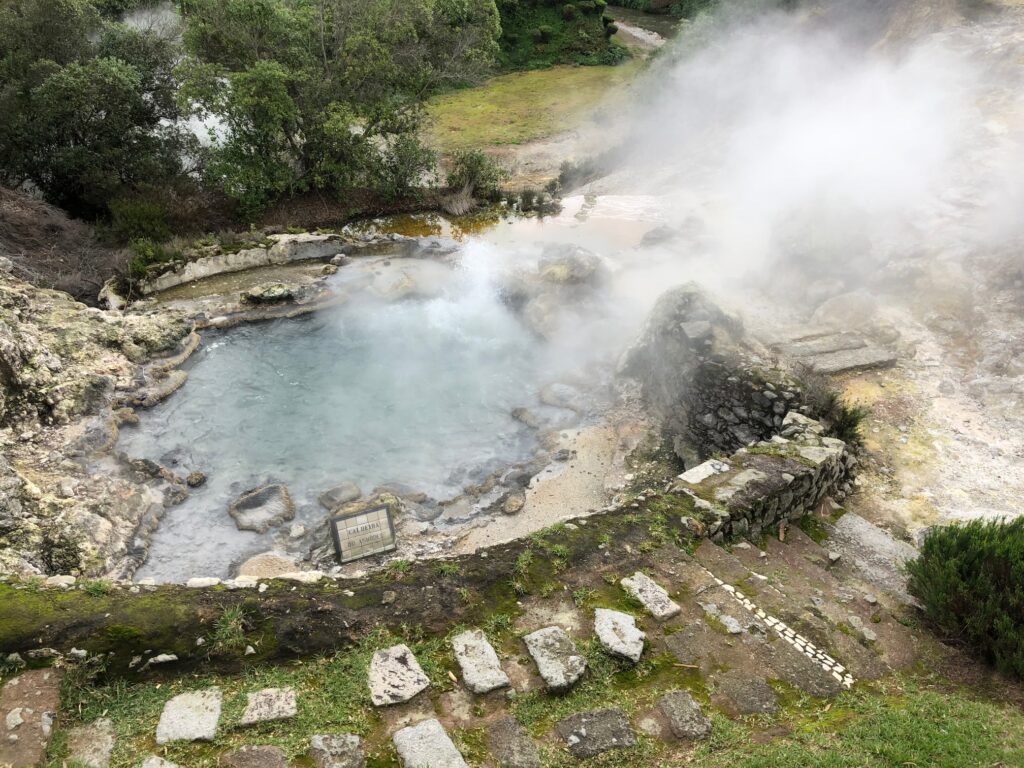
Broiling hot waters bubble in pools

Those waters released into huge 1920’s baths at the Terra Nostra Hotel
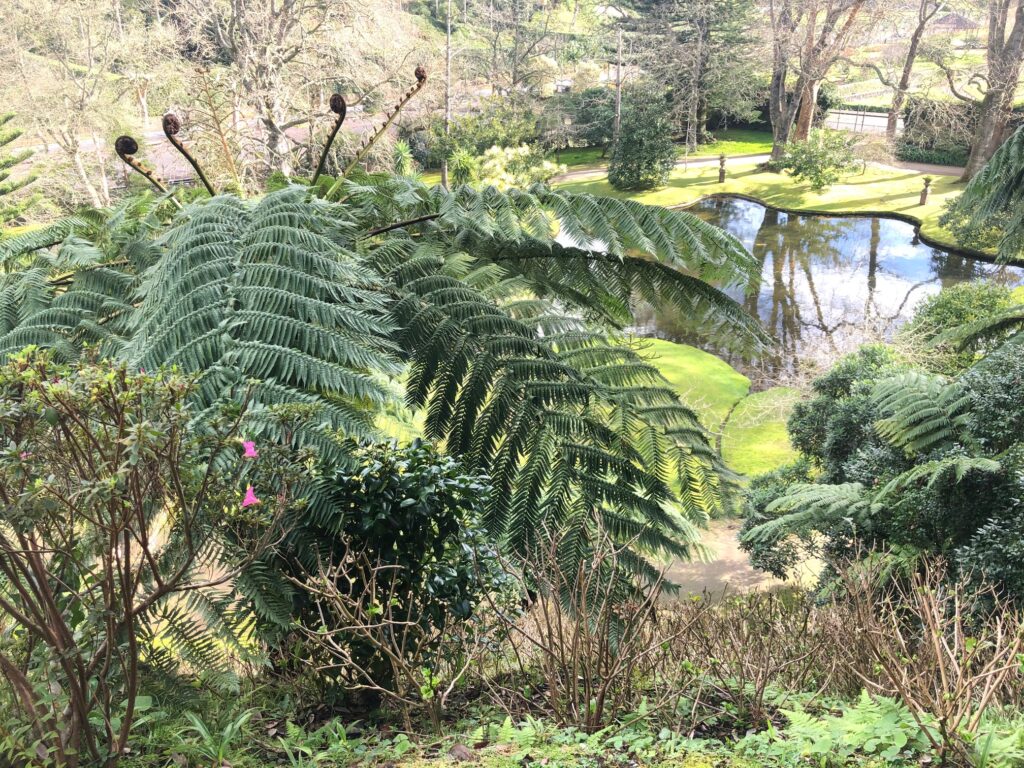
Located right beside an expansive garden
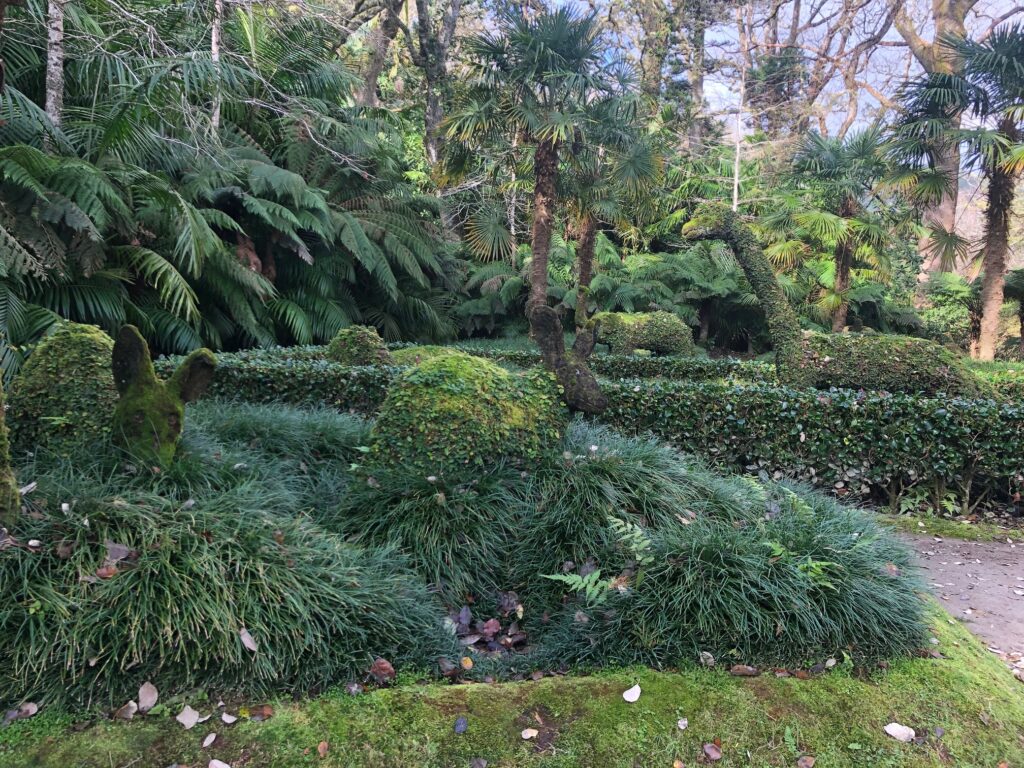
Topiaries
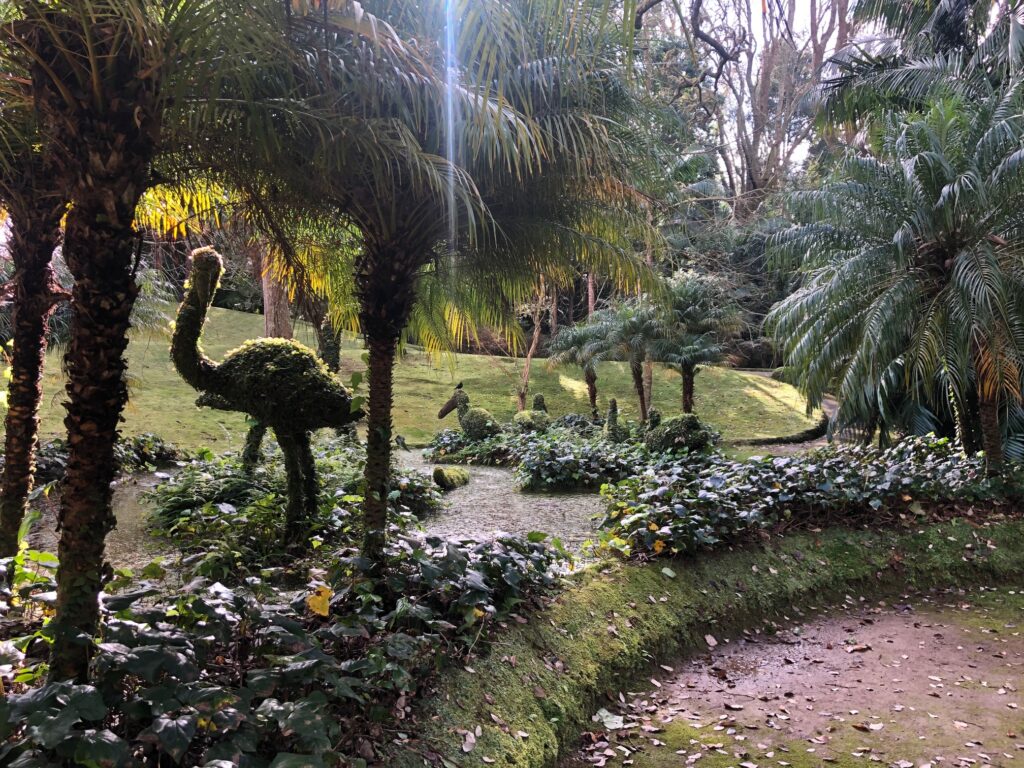
Palm trees
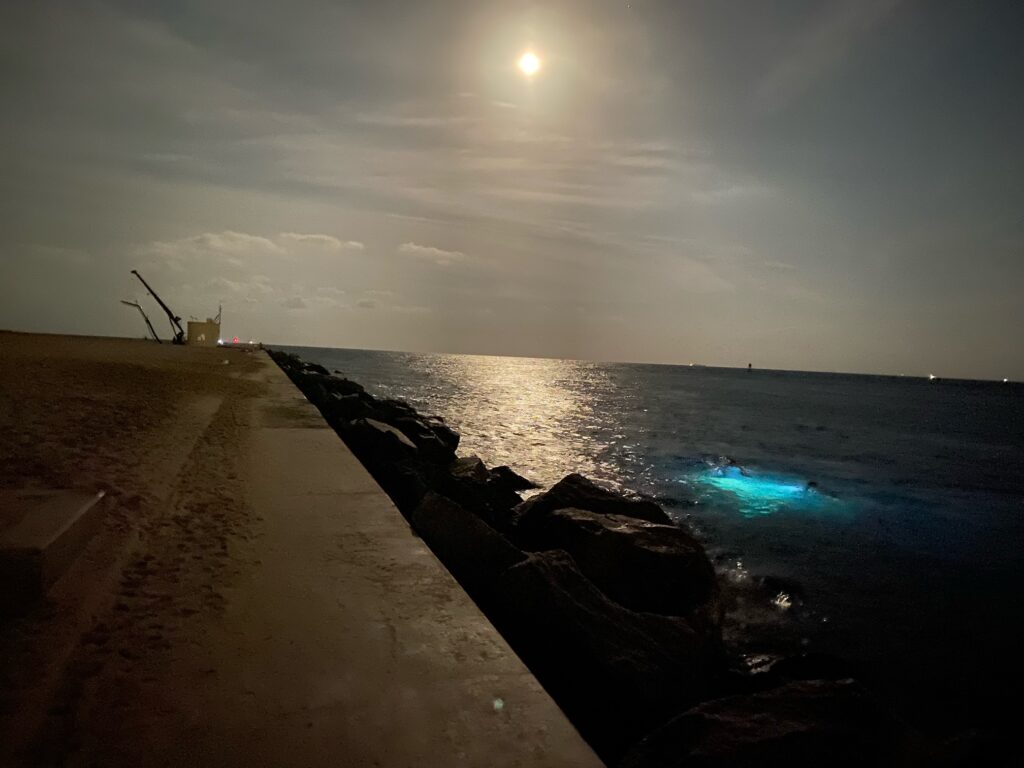
Pump Station on Singer Island, Florida on the night of the full worm moon, the last before Easter
Each and every time that we make an effort to begin the early stages of trip planning, I find that I must regroup. It is still too early!
We look forward to re introducing our tried and true trips to South America: Ecuador, Chile, and Peru. But we must admit, we are no longer optimistic about Fall travels.
We look forward to adding a new view tour to the Azores in 2022. It will be a trip postponed only two years if the islands in the Atlantic will be reopened for safe exploration in April/May next year?
We will have to remain flexible. We anticipate new rules including a requirement to show proof of vaccination for covid-19.
Certainly some favorite destinations like restaurants and galleries will have changed, but our good friends and local travel guides will be able to scout ahead for us all.
We expect to find old friends and new ones through referrals and quality accommodations (as before) at each of your destinations.
Here is a rough outline for you to consider:
2021 – Postponed again?
Sept – Picos in Northern Spain – hiking!
October – Dordogne and Vezere Valley of Southern France – Castles & Caves.
2022 – Possible
January 2022 – Ecuador is on hold at this time. Stay tuned.
February – Patagonia, Chile – we have an itinerary without dates. This may be early.
April – the Azores, “Hawaiian Islands of Europe” – We think this will be possible!

the closest lunar cycle of the year to the earth
We hear all the time from friends, “make sure to let us know when you are going on one of your trips. We look forward to traveling”! The desire to keep exploring keeps bubbling up. Every time I set a calendar to open the conversation about returning, there is another spike; another warning to remain diligent – to avoid unnecessary travel!
Our simple understanding is that future travelers will want to be together in small pods with other known family and select friends. Of course, everyone should feel comfortable before departure about the group they are in.
I will continue to listen for reports from each of our destinations. The French are taking short day tours in their own country – on occasion. The Chileans have had to shut down again, but we have a marvelous itinerary drafted for the time that we can return. Ecuadorean guide Ivan, our hosts at Hacienda Cusin and El Refugio have continued welcoming a few guests, usually local travelers. While it is too early, still, I am reassured, we will be welcomed back as their North American guests!
That’s all for now!
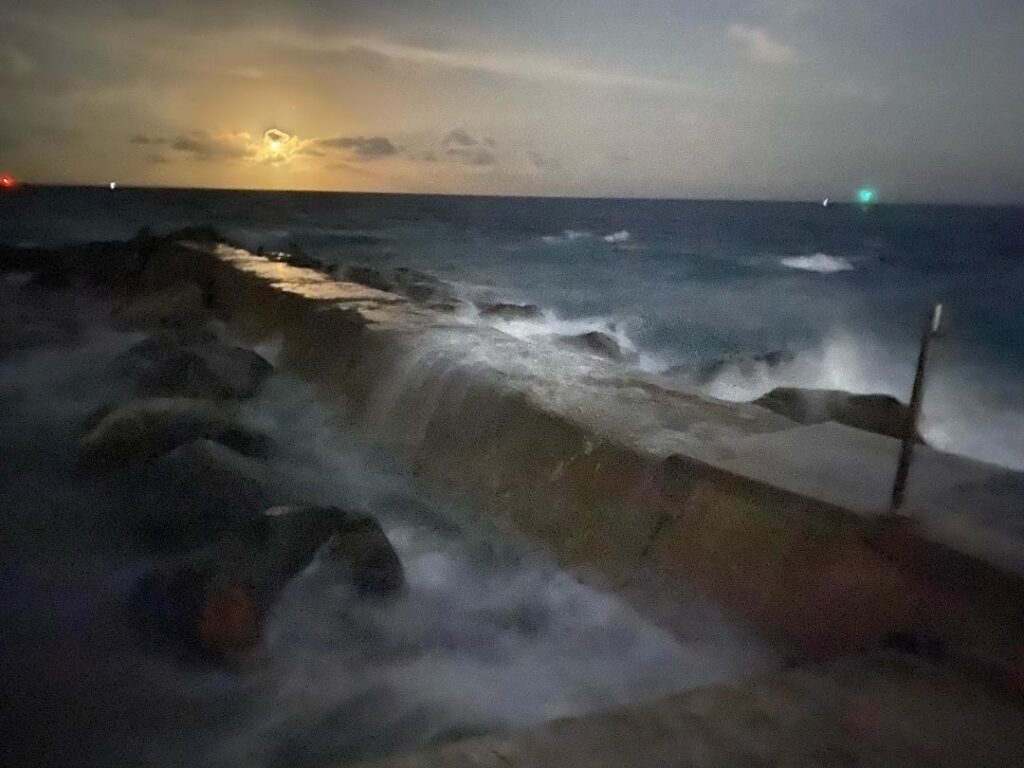
Pump Station on Singer Island, Florida on the night of the full worm moon, the last before Easter

March 17th, 2020
Dear Travel Friends,
Due to the current unprecedented pandemic, New View Tours travel plans are, of course, now on “hold”: this includes the two Fall trips to France and Spain and the two trips for Winter 2021 to Ecuador and Patagonia.
The impact of the quarantine is unknowable right now as countries completely close their borders. Ecuador has turned back international flights arriving from the USA and other countries days before other countries with only 5 cases reported. (As soon as I write this, the numbers will change – incredible times) We anticipate increasingly restrictive quarantine steps across each state in the USA to mitigate the spread of the virus.
New View Tours will watch the recommendations of the CDC and WHO. We will not travel anywhere during this period.
Next steps: We will make decisions on the currently scheduled trips 60 days before departure. While our policy is “your deposit is non-refundable”, New View waives this for this year, 2020. If you would like a refund, let us know. Or if you would like to “wait and see”, we will hold your deposit for the trip of your choice when it is possible to travel again. We are glad to reschedule a postponed trip at your convenience as a group or as an individual tour.
We are watching as the travel news changes all the time. As restrictions ease and we have a clear view of what might work, we will be in touch with you. It will certainly be interesting to learn about what the new world of travel will look like to and from Europe and South America.
We do look forward to planning trips and traveling with everyone to our favorite destinations: Ecuador, Peru, Chile, Argentina, France, Spain, and the newly added Azore Islands.
See a few pictures below!
To each of you, our friends near and far,
be safe and take good care.
Ramelle & Michael
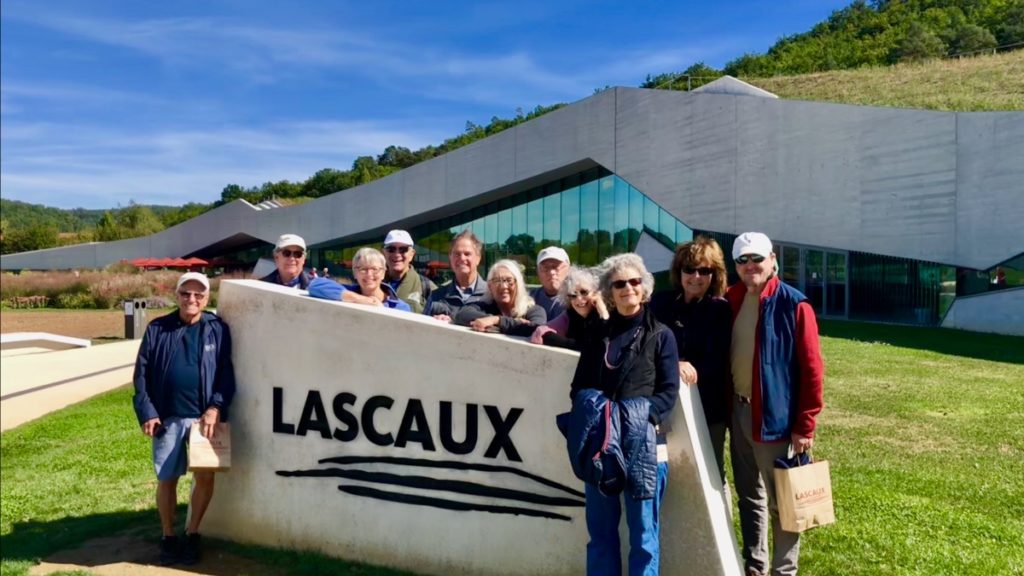
Lascaux IV – a new museum opened only 4 years ago. It is a complete reproduction of the original cave located only 500 meters away. Marvelous place! Lots to learn from the technology that made it possible!
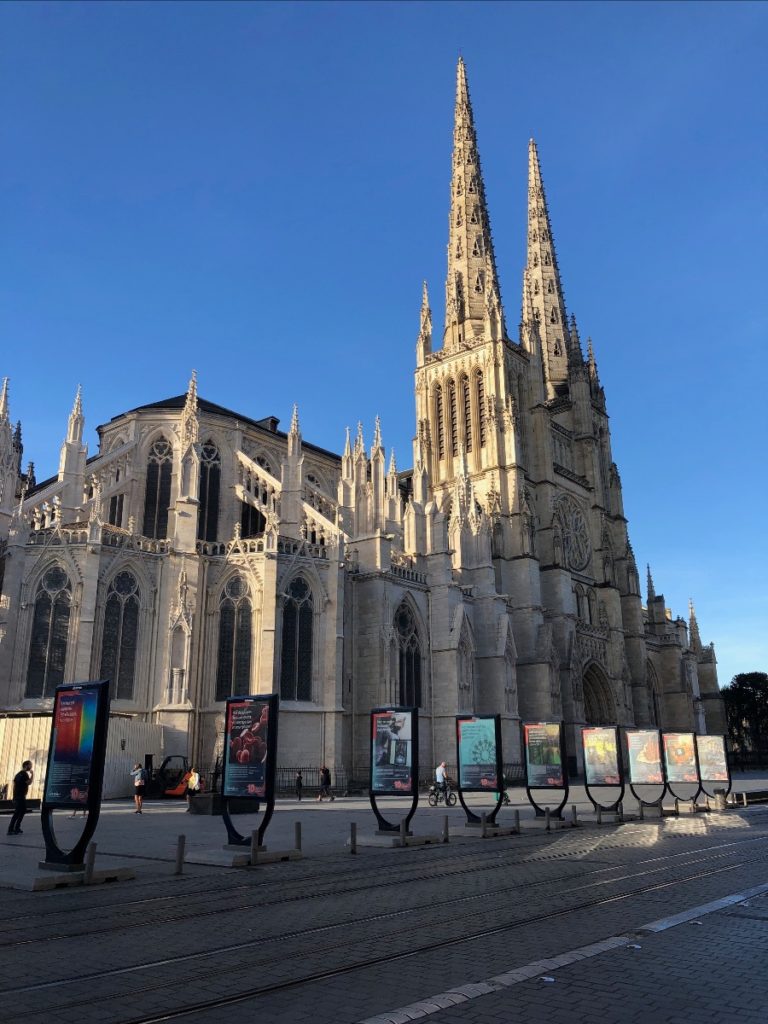
The Cathedral in Bordeaux – newly cleaned!l
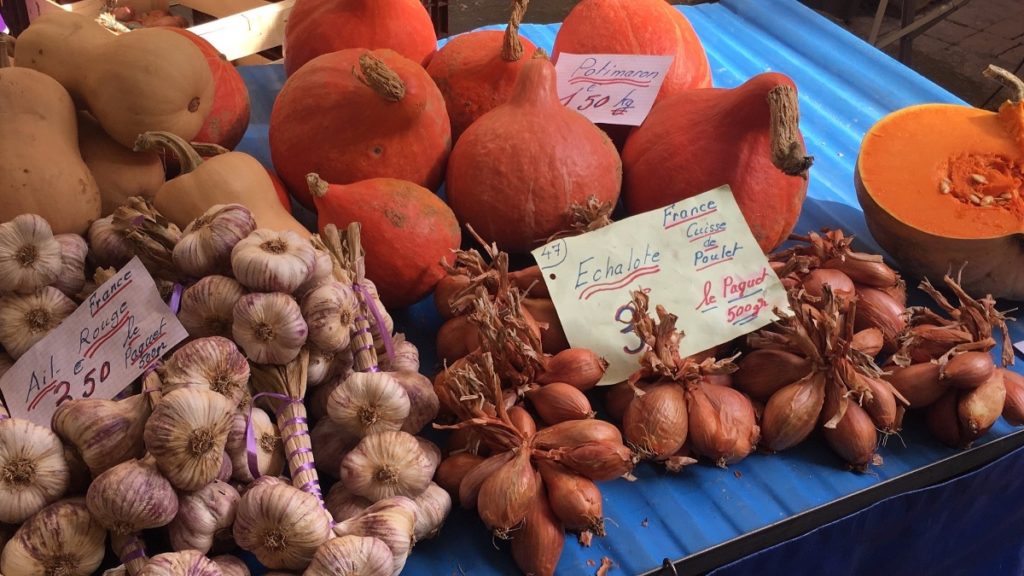
Markets of Sarlat feature delicious abundance of produce – squash, pumpkin and garlic! Let’s cook! Sabine has an afternoon cooking class where we will watch, learn and taste how she does it!

Market place of painted plates – Cordoba Spain
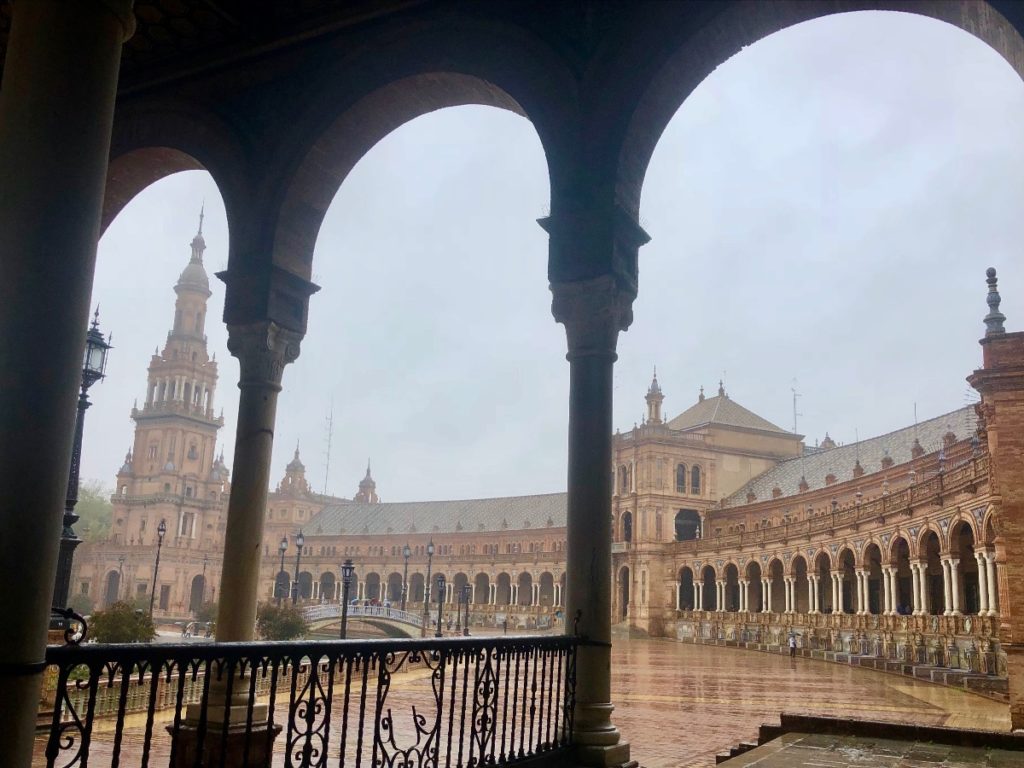
Spanish Plaza built for the Worlds Fair in Seville
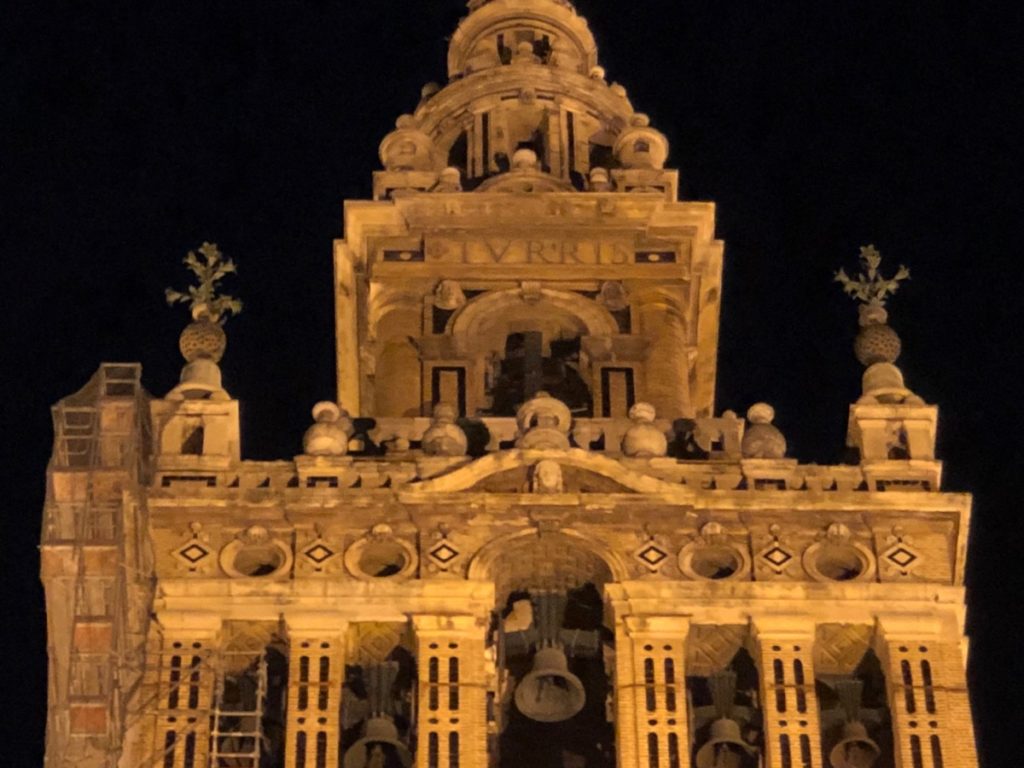
The Seville Cathedral at night.
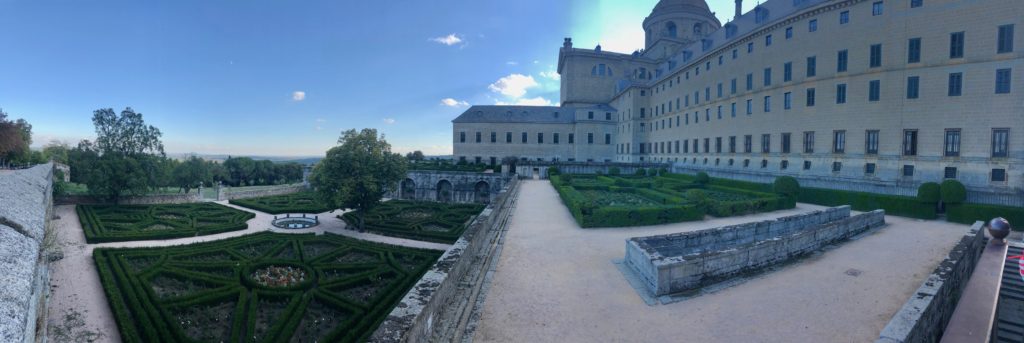
Ecuador is a country with a varied history of tribal cultures and conquest. The country enjoys the equatorial sun with coastal bounties of fish and beaches along with the high elevations of the Andres mountain ranges. This range in geography provides the country with a rich biodiversity in plants, birds, butterflies, and animals. Ecuadorians proudly display their country’s culture and assets in numerous murals around their cities. Here are a few of my favorites and the cities they are located in.
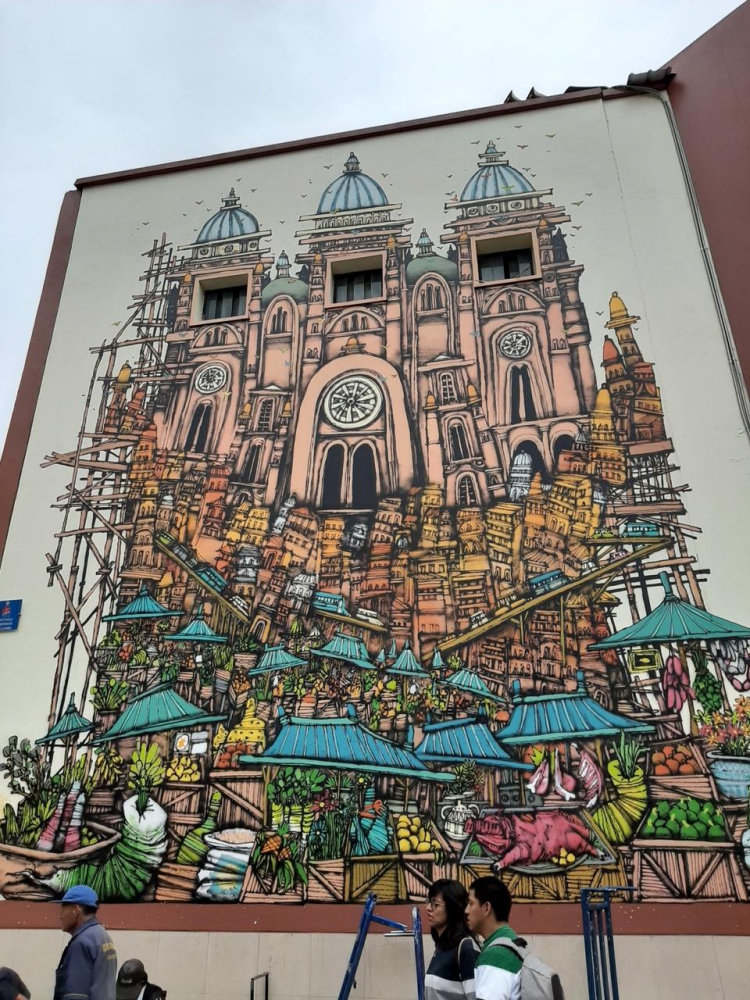
“Going to Market” is an integral aspect of shopping in Ecuador. Everyone makes time to go to market for the fresh vegetables, flowers, meat, baked goods and pretty much anything one may want to find. One mural I found in Cuenca was painted on the side of a building that housed a large city market. In the large mural a viewer can first see three spires of the landmark Cuenca’s Cathedral at the top. Below the spires the artist depicts layers of “homes” and buildings resting on a collection of blue tents and market produce indicating the interdependency of the local residents and businesses on the market enterprises.
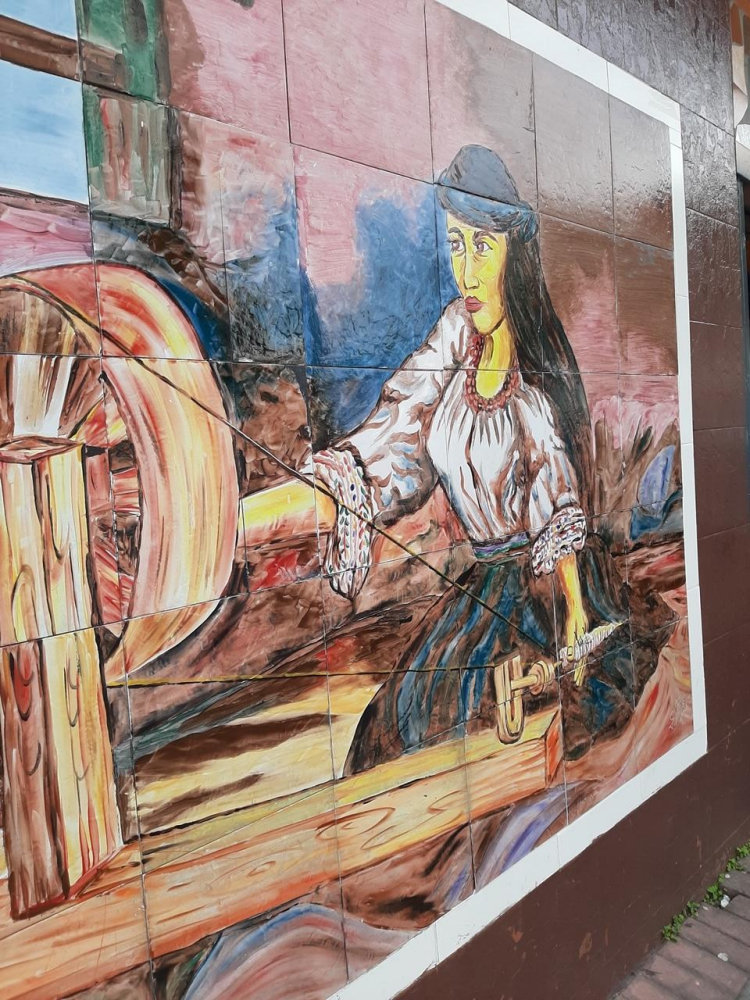
Another tribute to market place activity is the placement of tile collection that depicts a spinner/weaver working in her home. Weaving and textile production includes the raising of sheep, llama, and cotton which provide the materials to support a vast home industry of spinning, weaving, and knitting of numerous variety of fiber goods. Many of these items are available in the market or at some of the very fashionable shops that are popping up to accommodate some of the tourists’ trade or relocated expatriates.
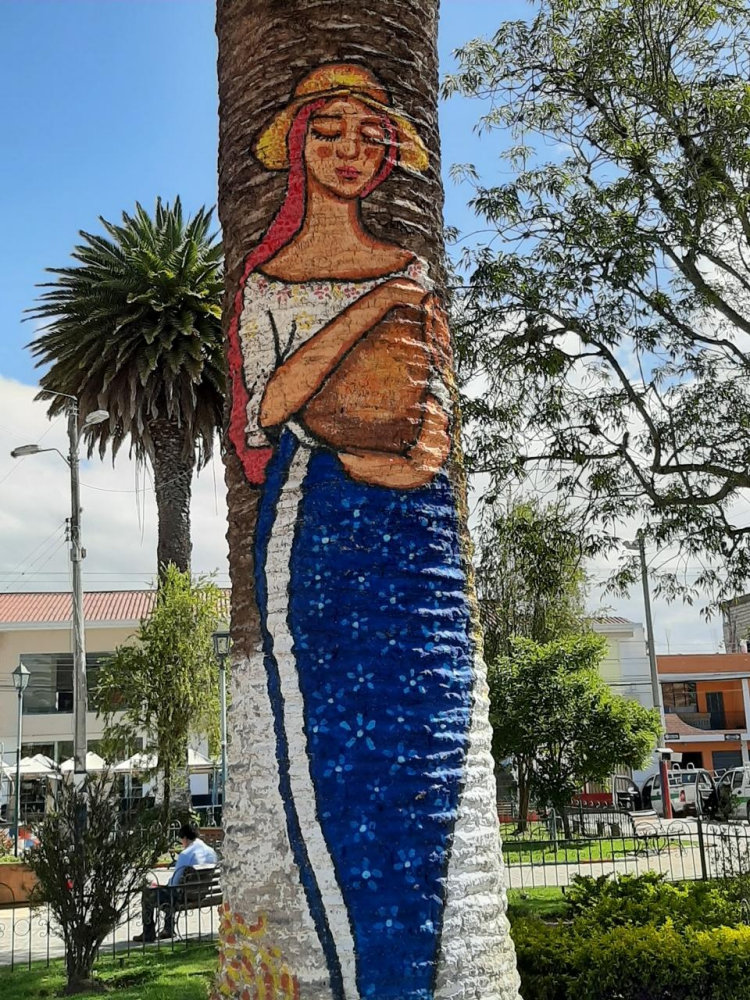
In one of the many parks that dotted Cotacachi I found this whimsical tree painting. Parks are a vital component of the Ecuadorian social life. Folks will gather in the parks to escape the midday sun which shines directly overhead, listen to music or political speeches, meet neighbors, or just to relax and people watch. I found this decorative tree painting very entertaining and a fun find.
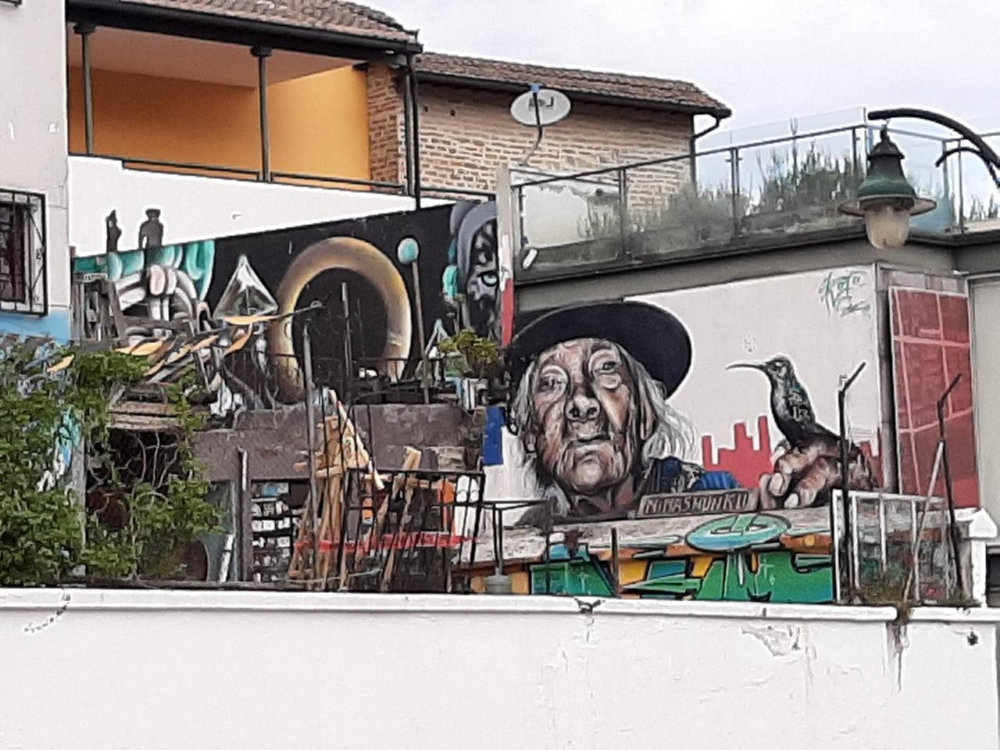
There are times when the murals recognize prominent Ecuadorians that contribute in special ways to the country. Nina Shunku has been working successfully with the “Pachaysana Project”. This is a project that addresses obstacles that plague almost all small nonprofit organizations. Using micro investments and workshops, basic conflicts in organizational communication and planning are addressed while bringing urban arts programs to hundreds of local community members. Her results over the last 2 years has more than doubled the investments and enabled the project to evolve and expand. Her accomplishments are reflected in a mural on the balcony of a building where dance and art continue to be taught. Notice the hummingbird in the mural reflecting one of the charms in Ecuador.
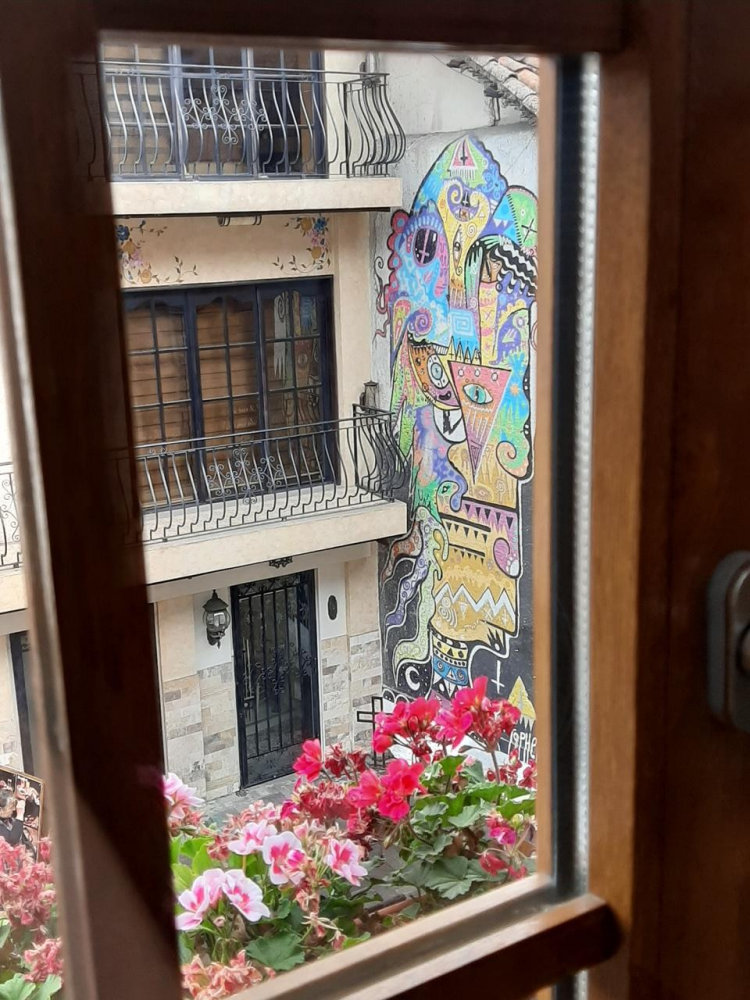
My favorite was the view of a playful mural right outside my window at the Hotel Victoria (Cuenca). The colorful mural is painted on the wall of a little restaurant (with great baked goods) by a local artist. The image captures and displays the spirited fun of this neighborhood with its many restaurants and evening music venues.
Ecuador is an amazing country. The murals that I have described are just a glimpse of what the country has to offer a visitor. Enjoy….
